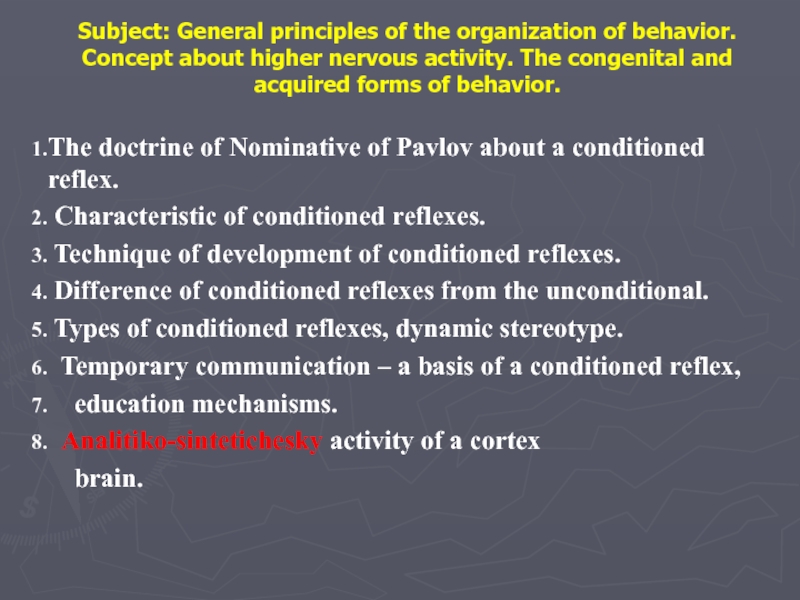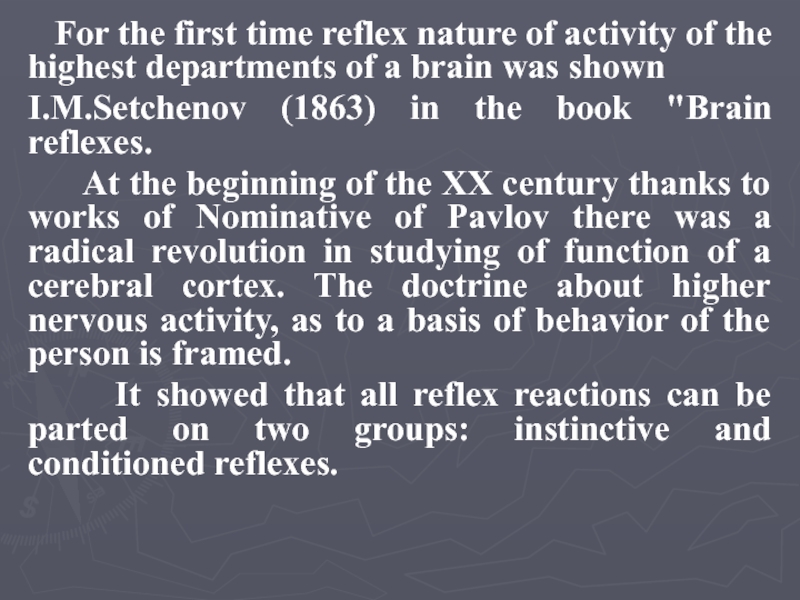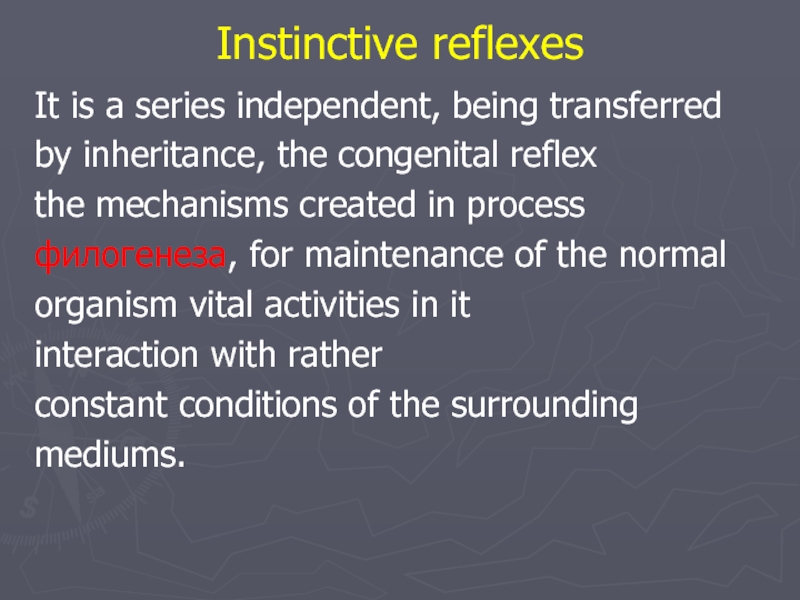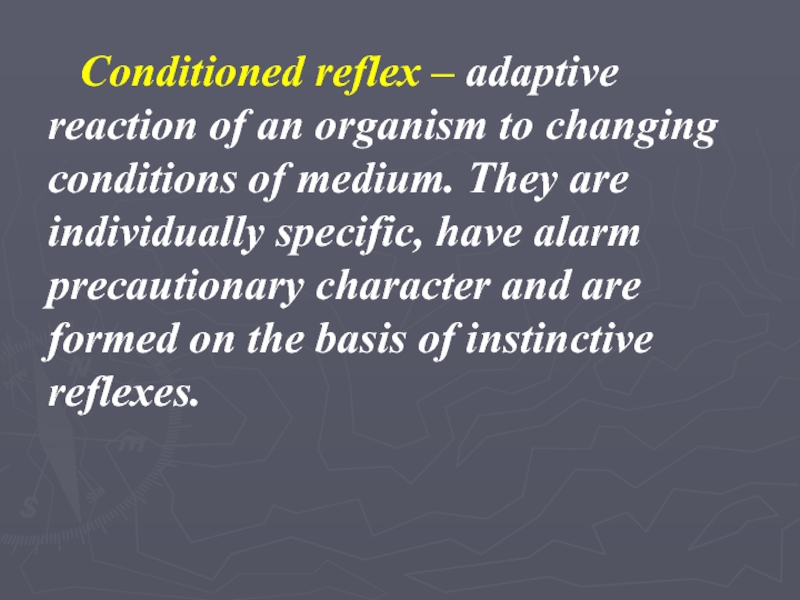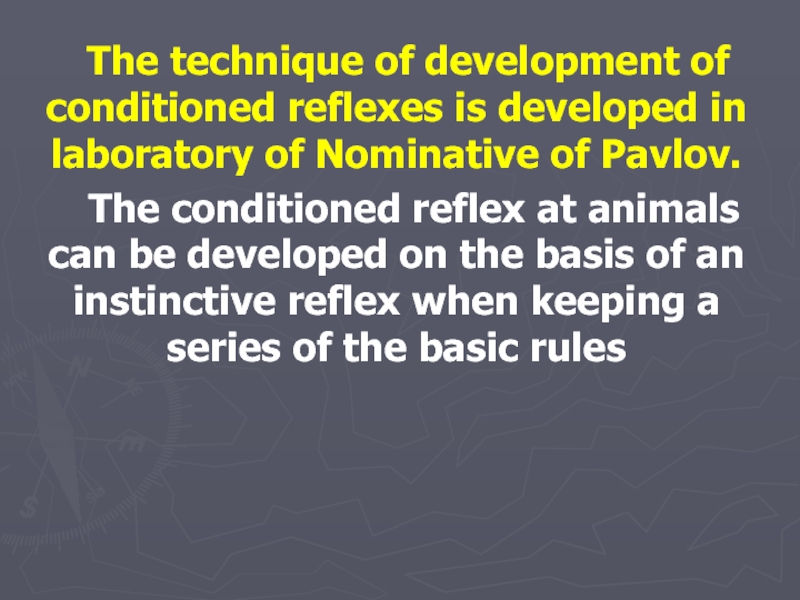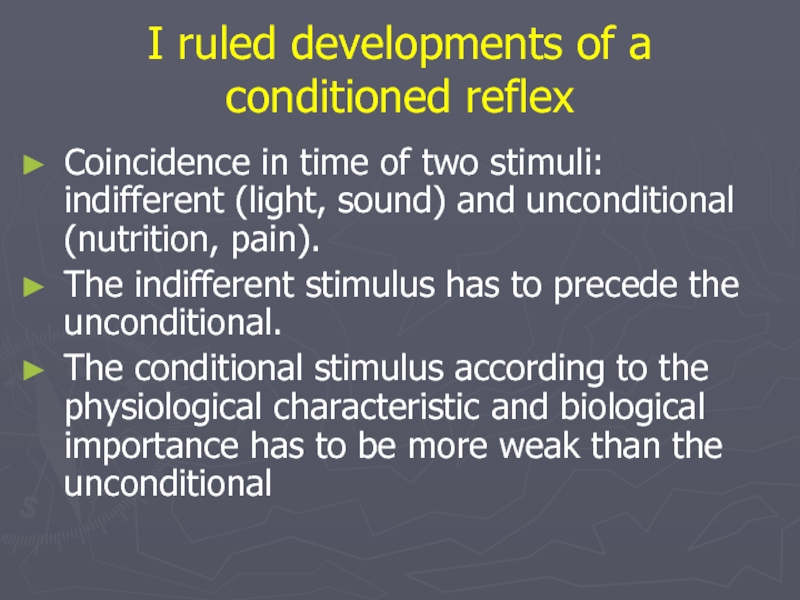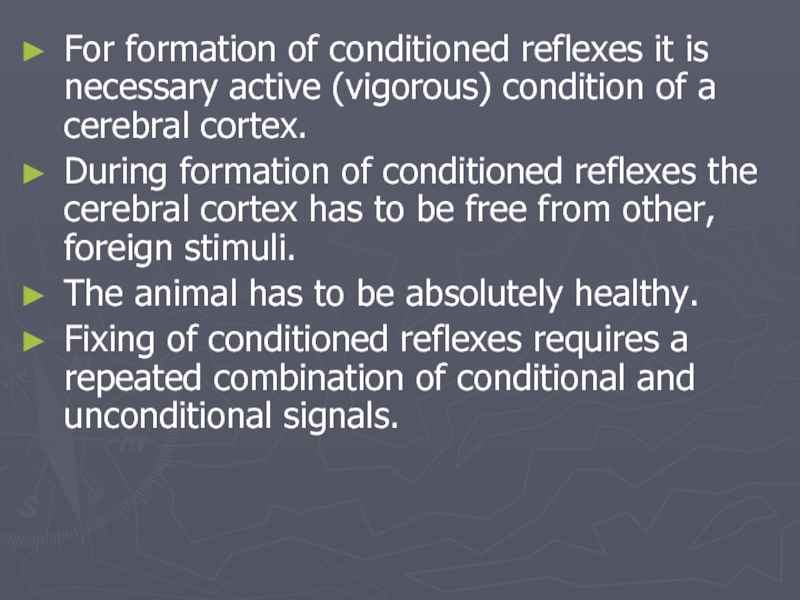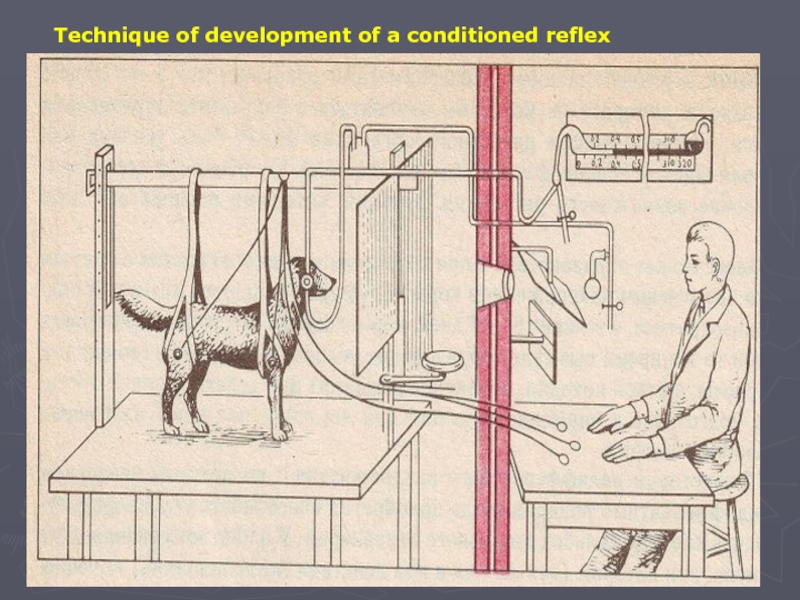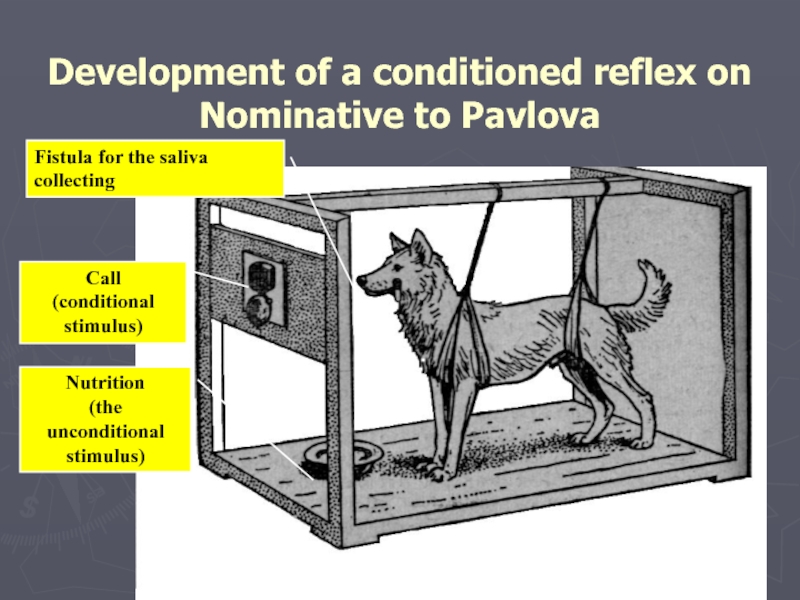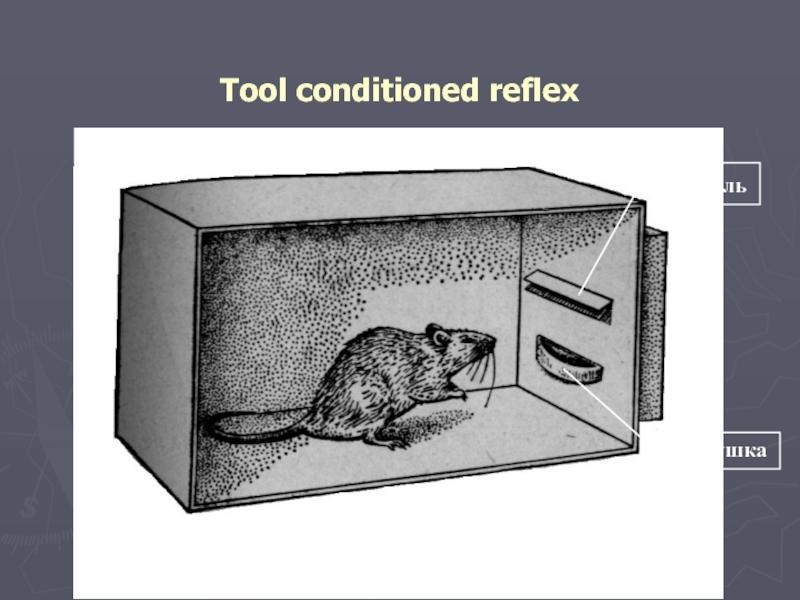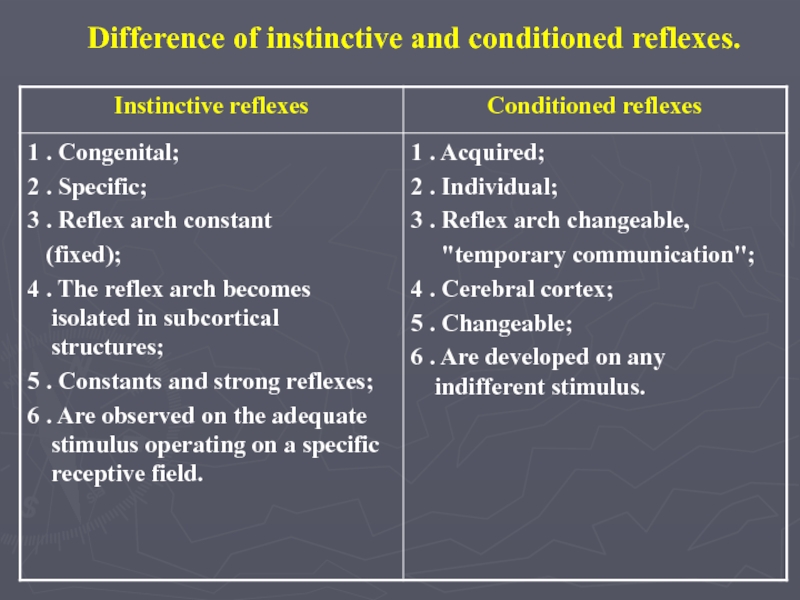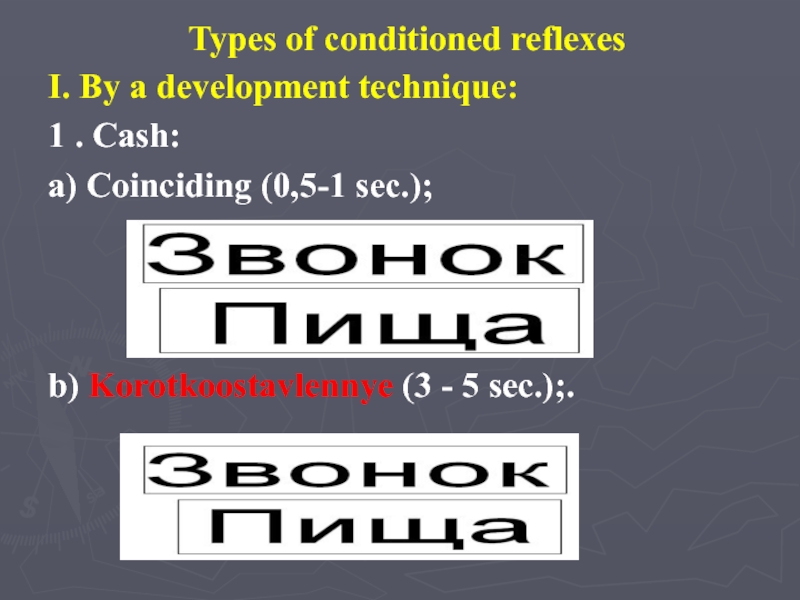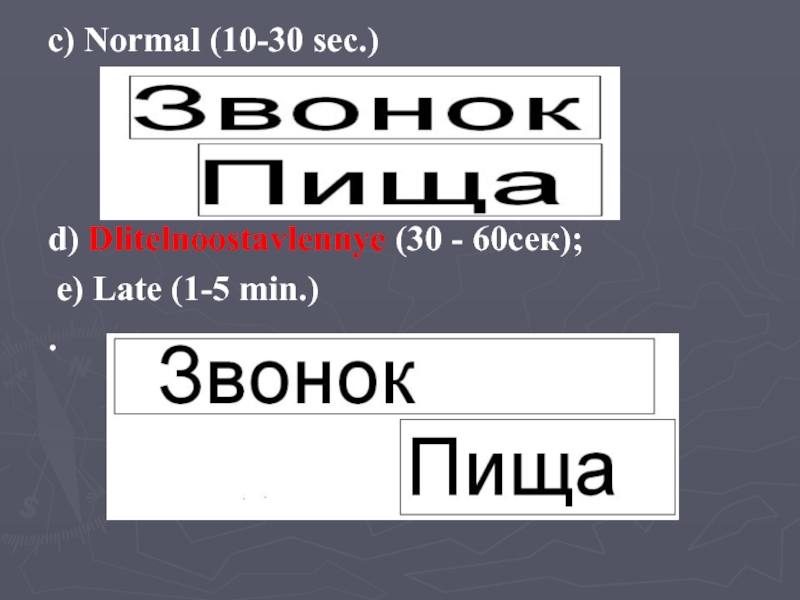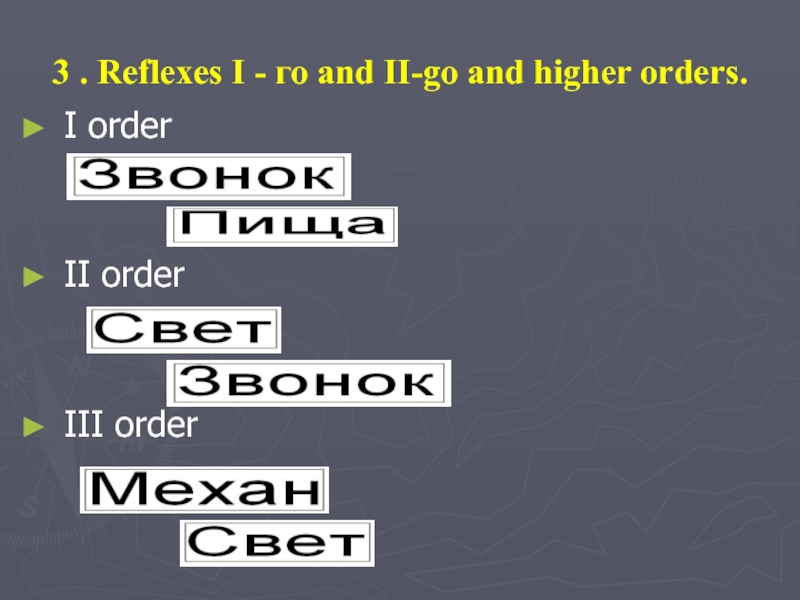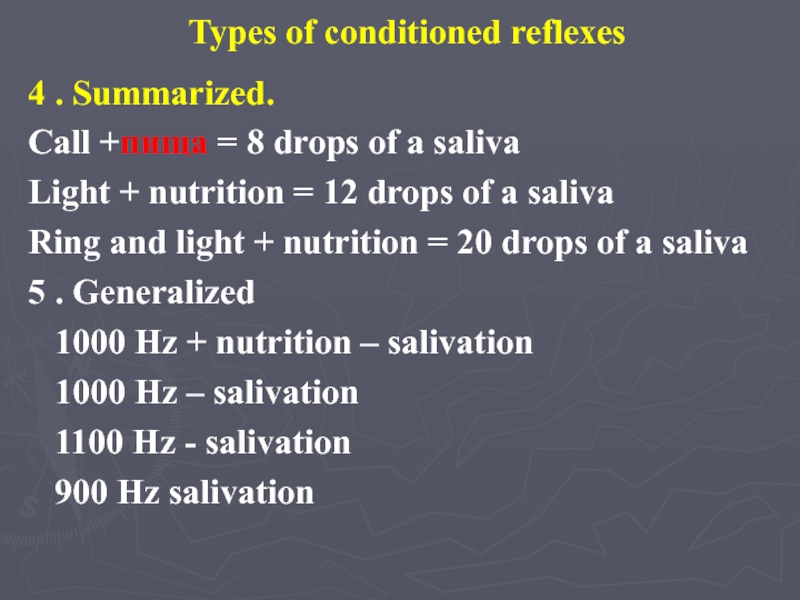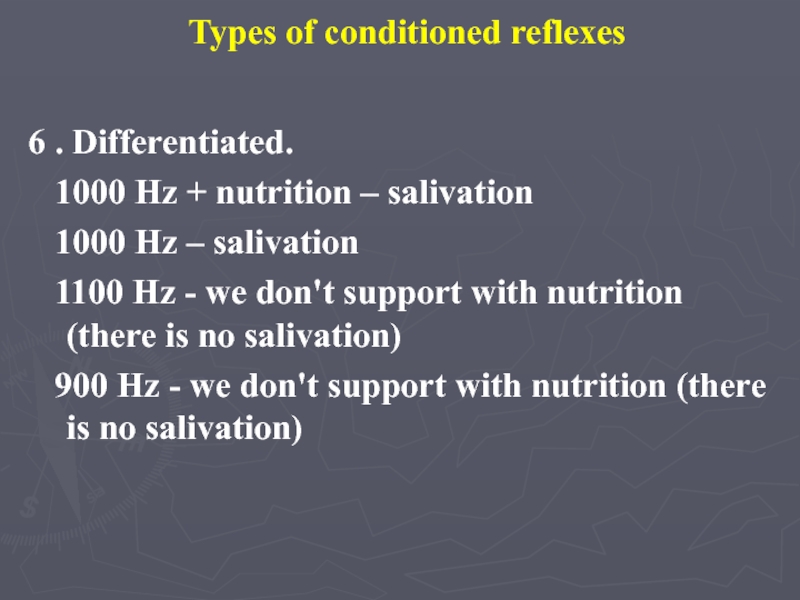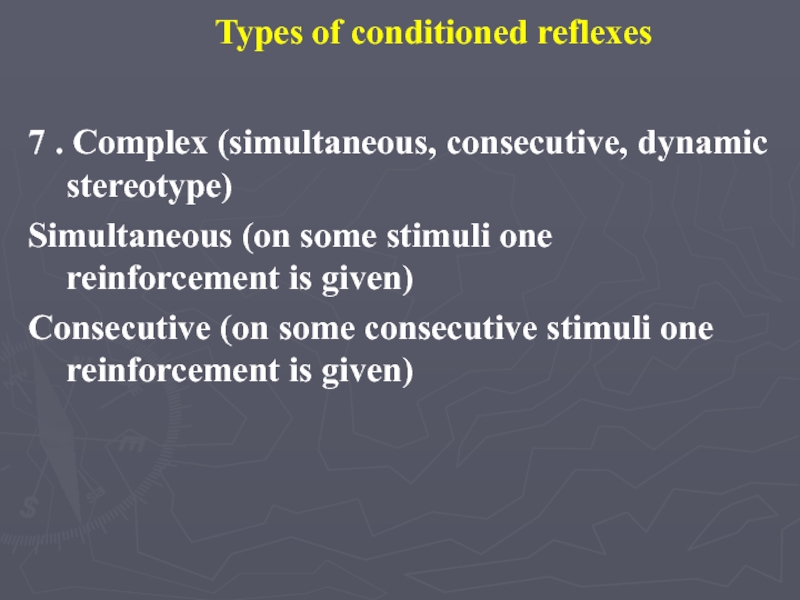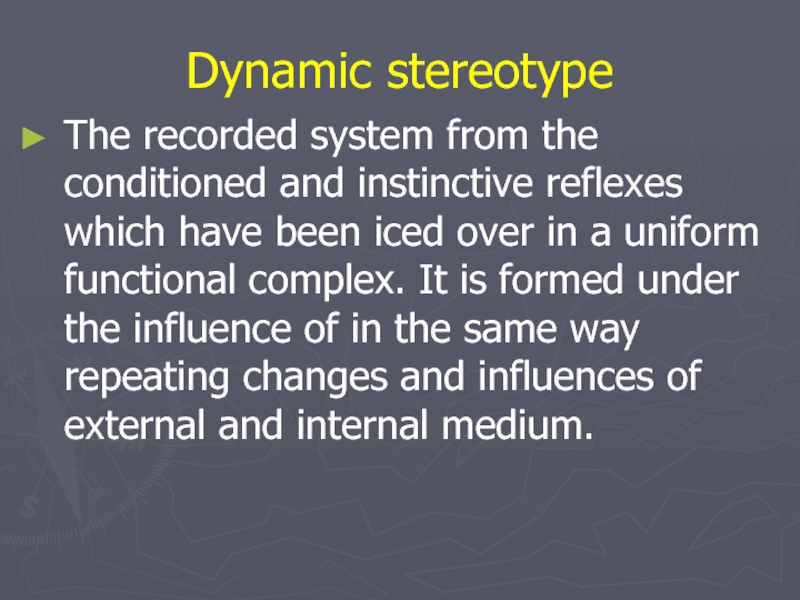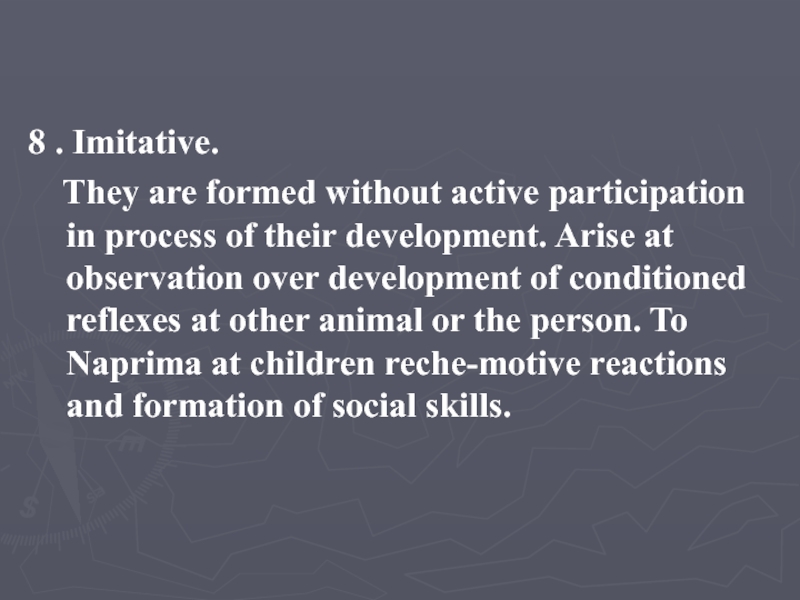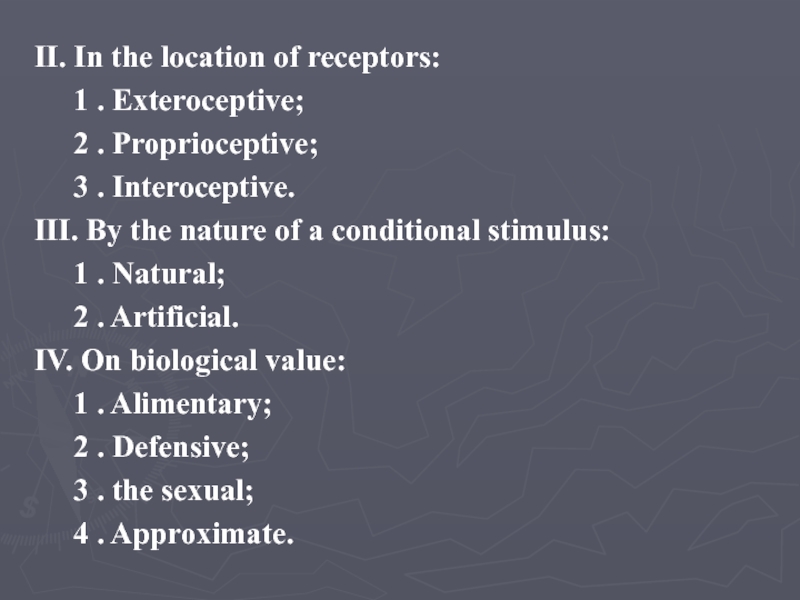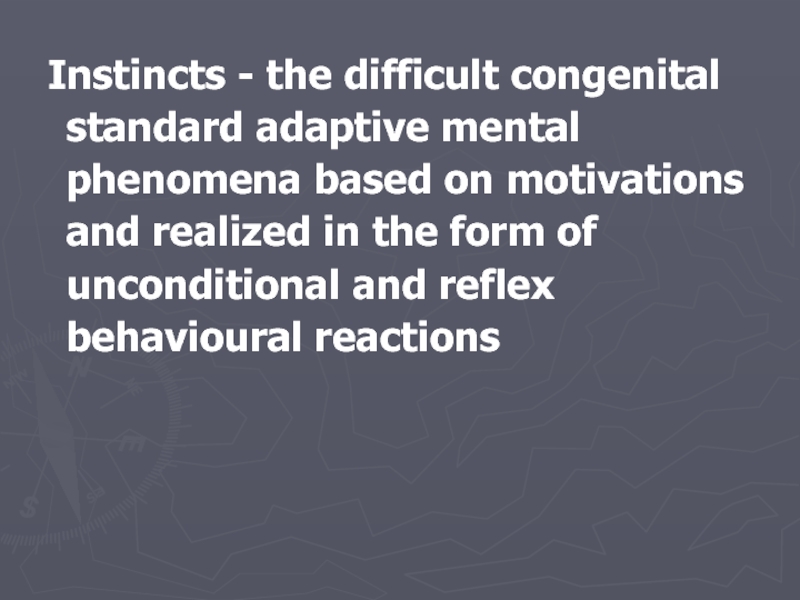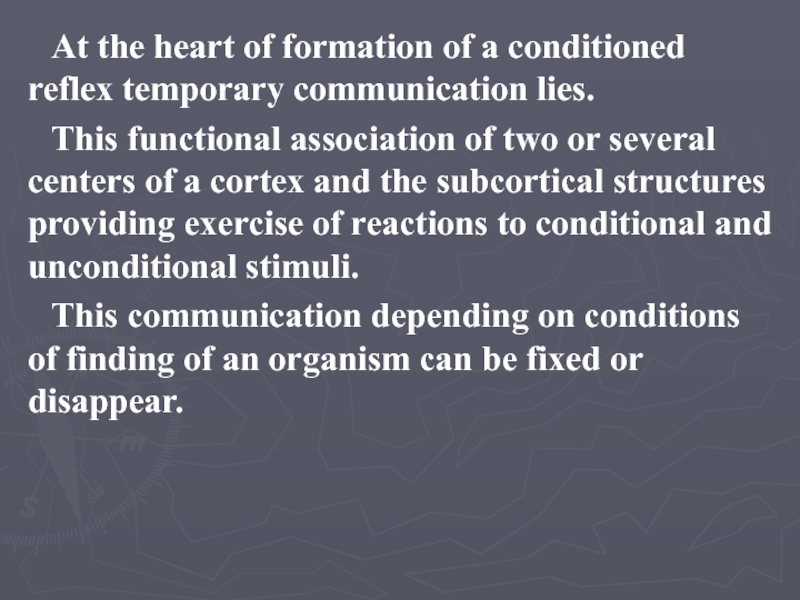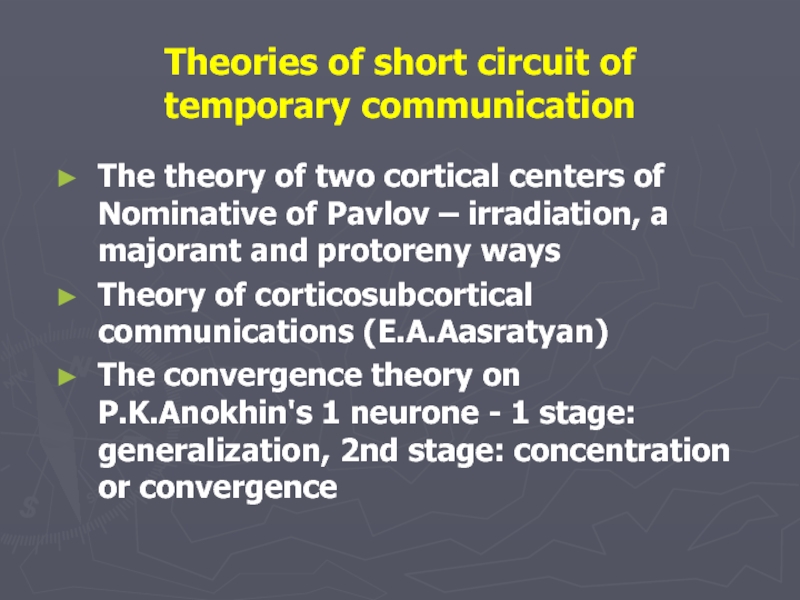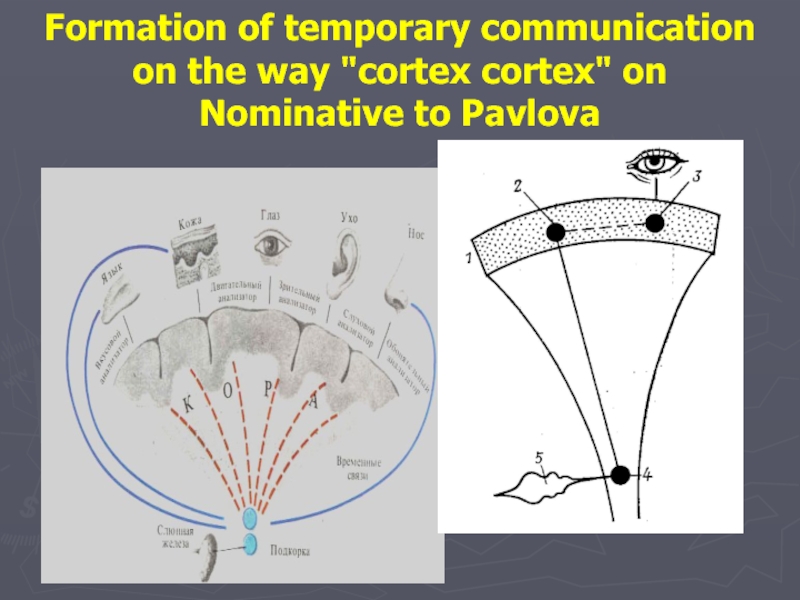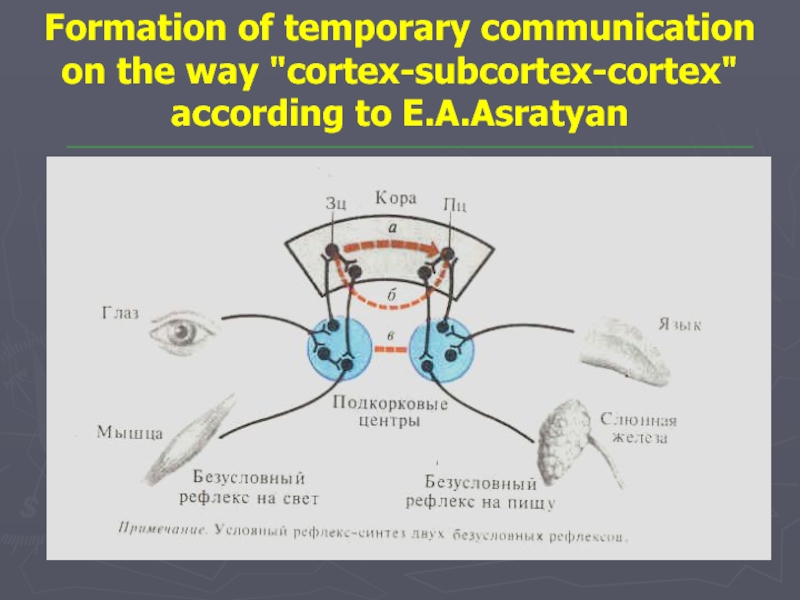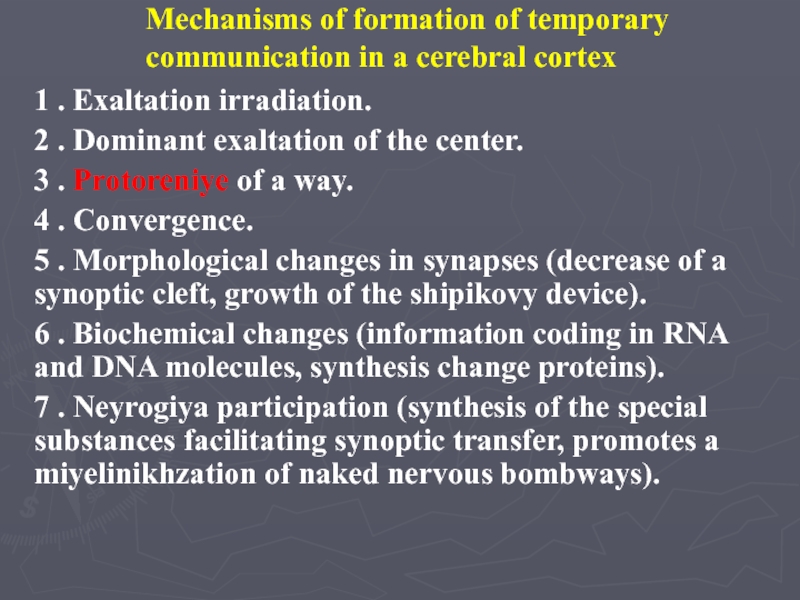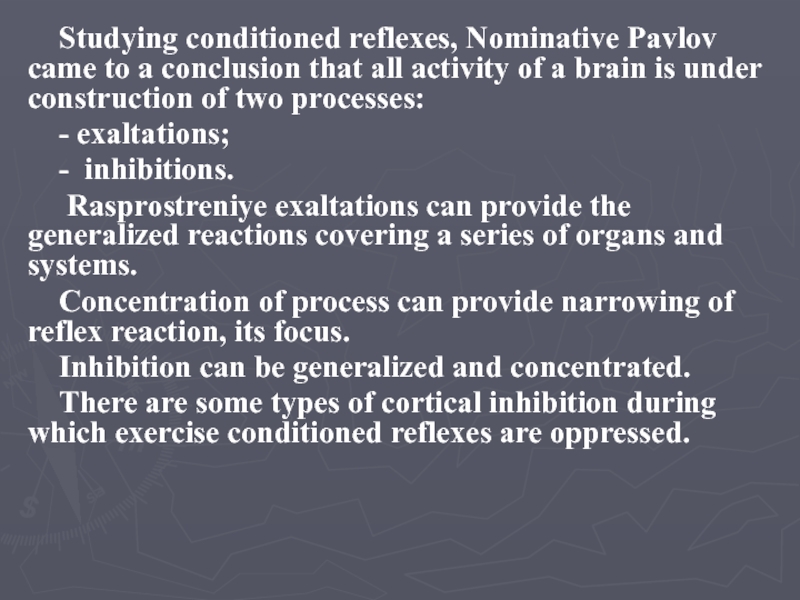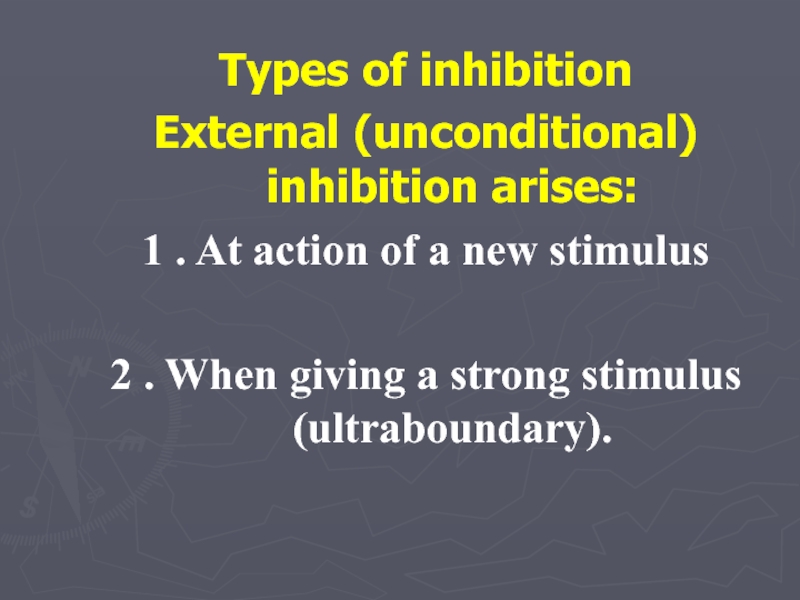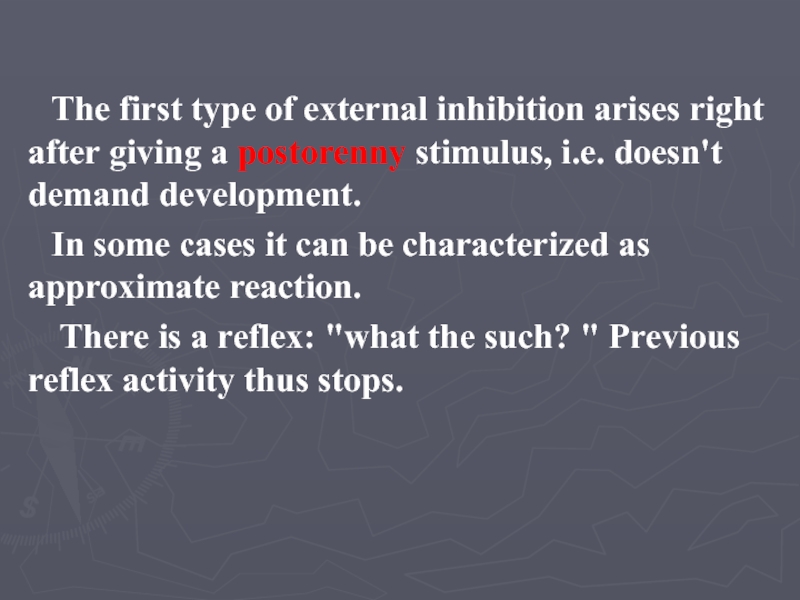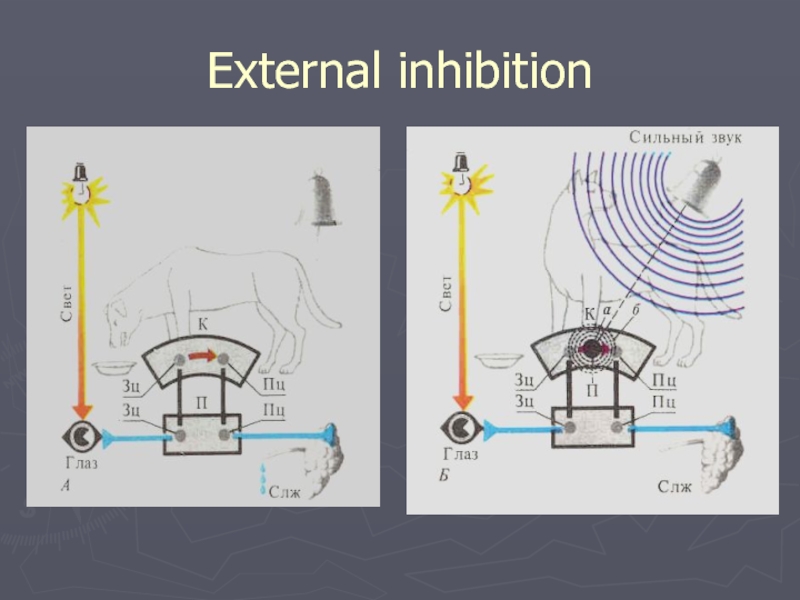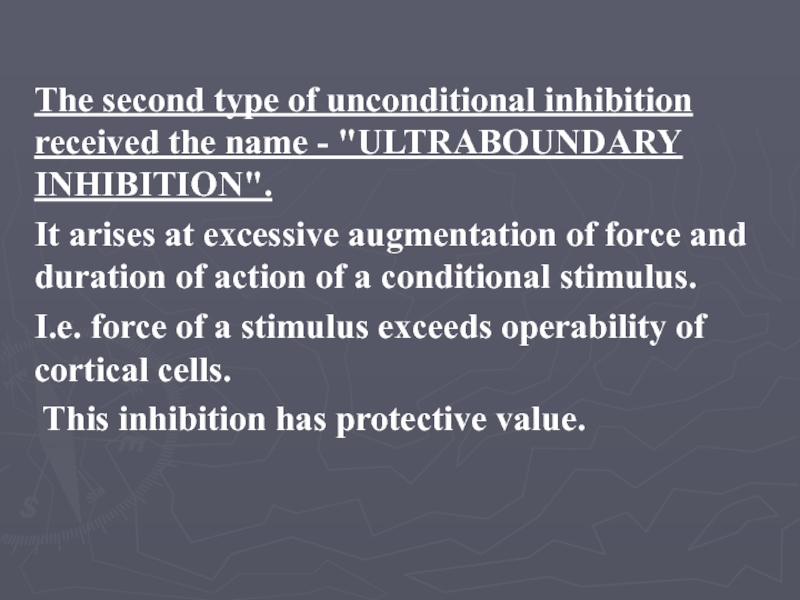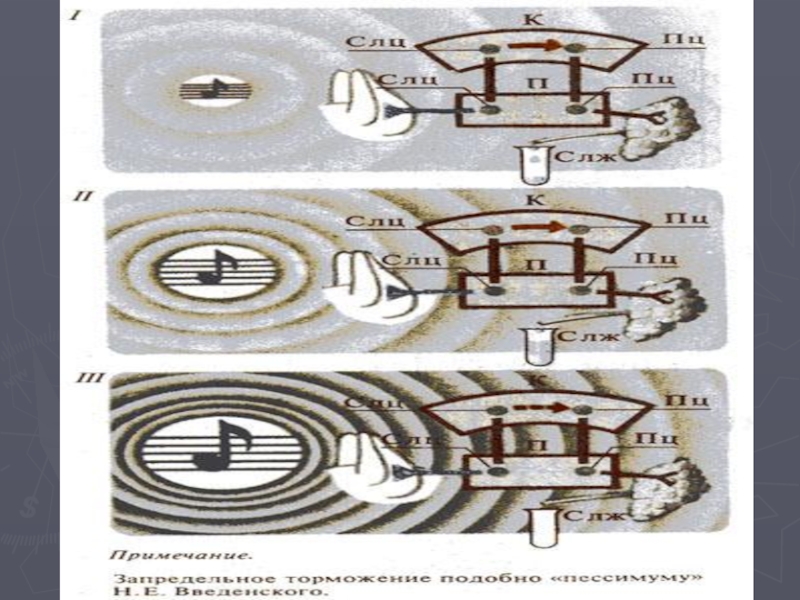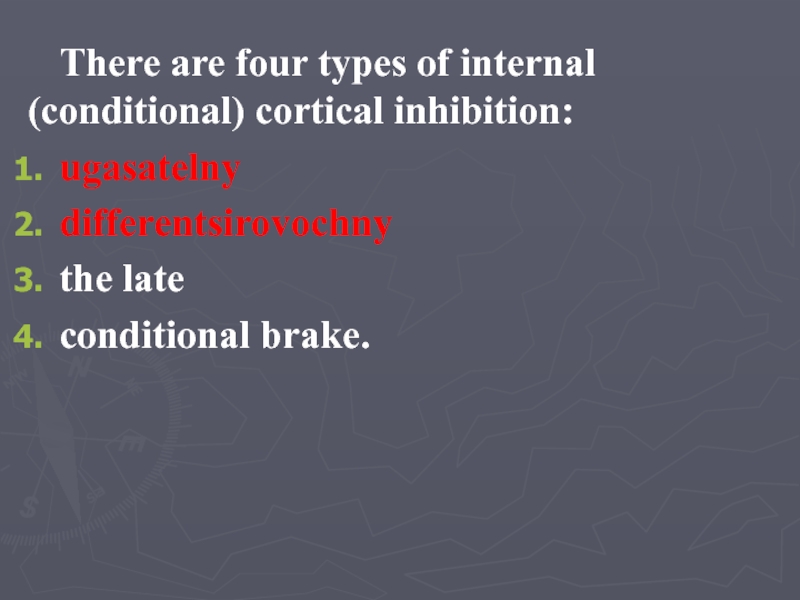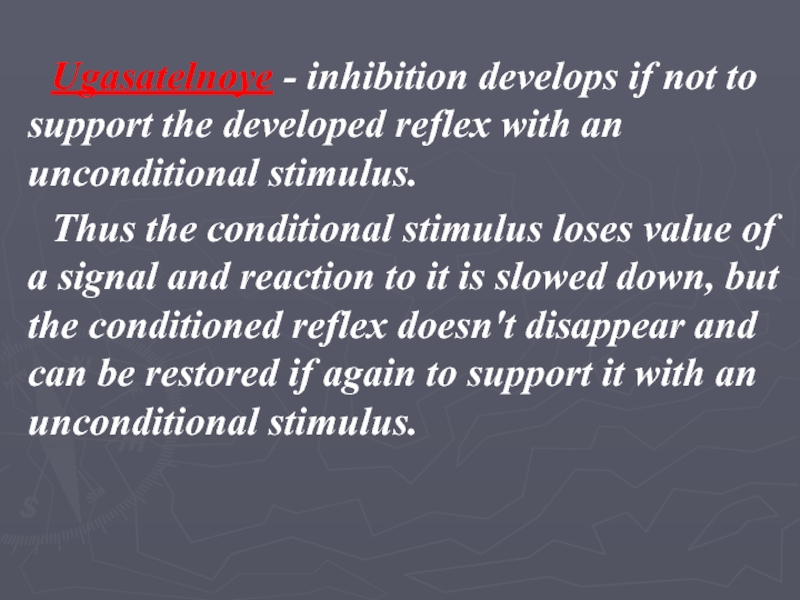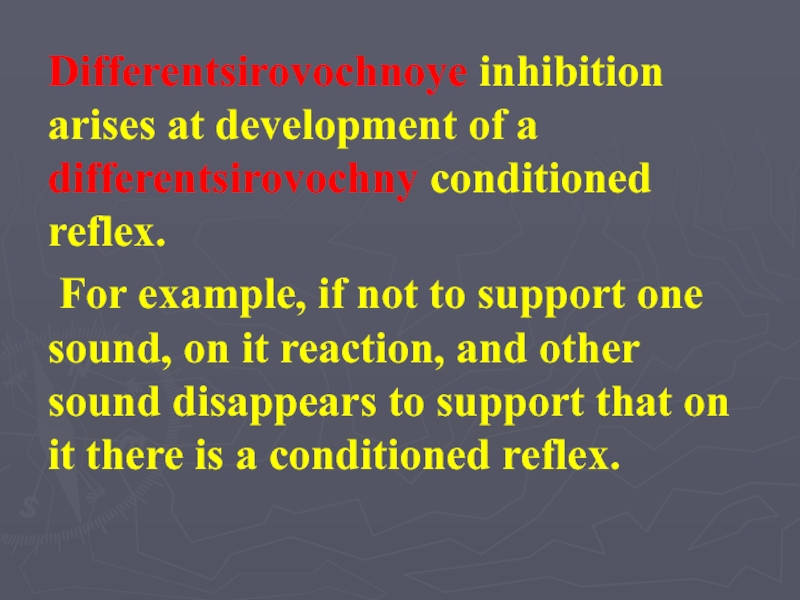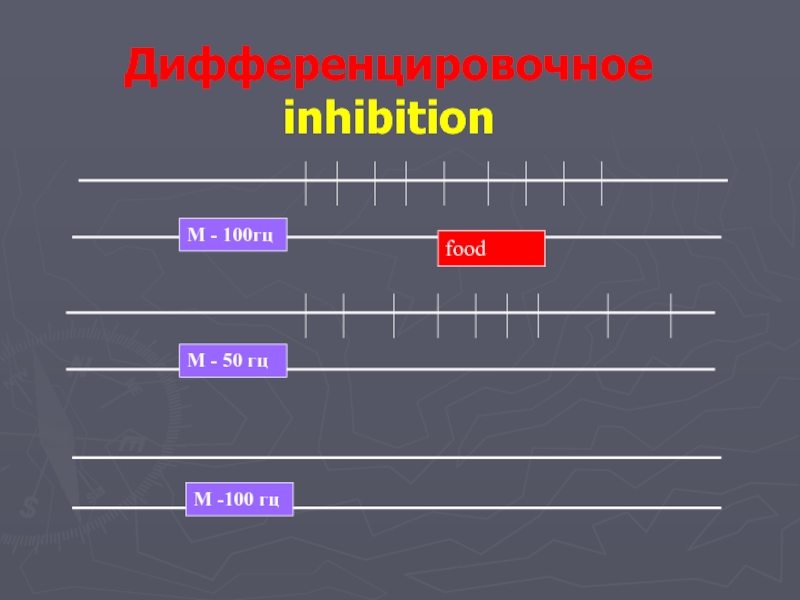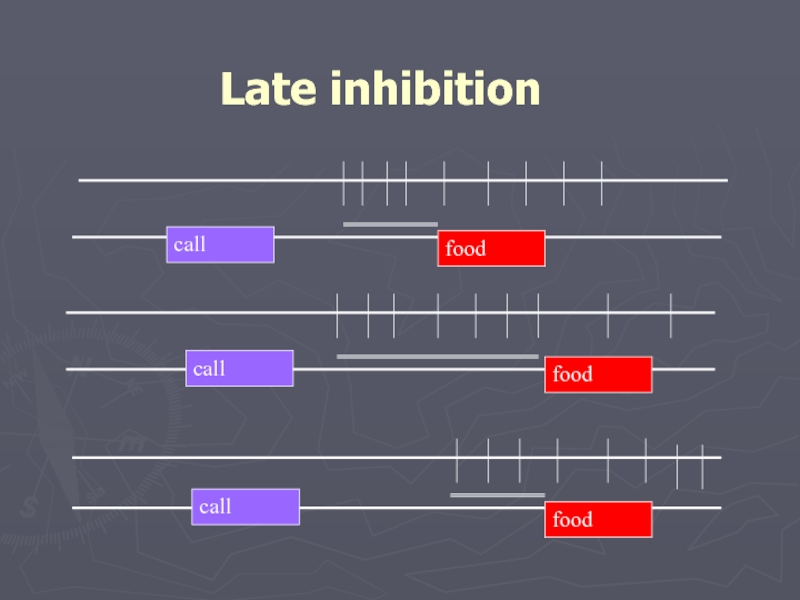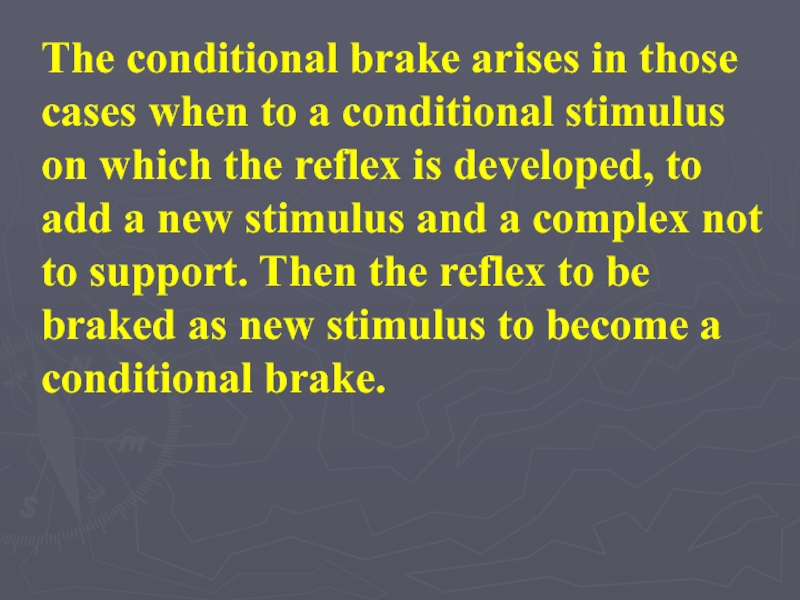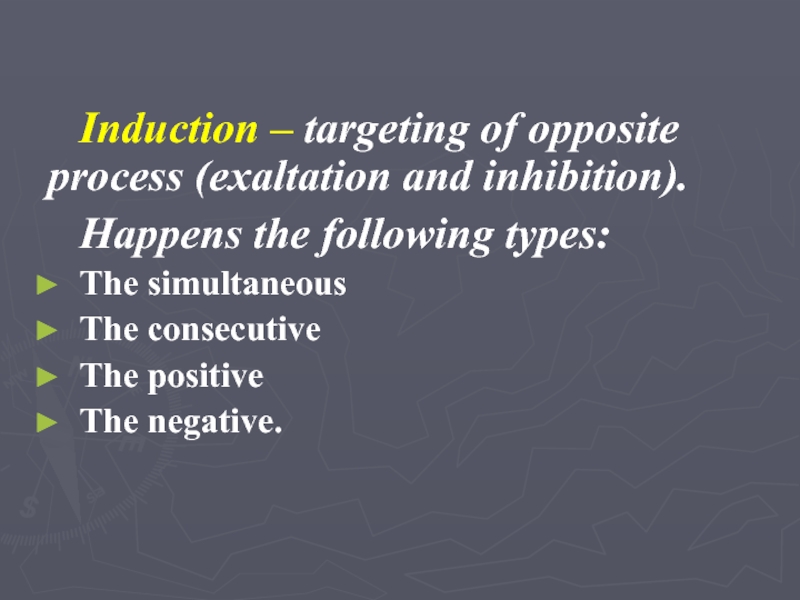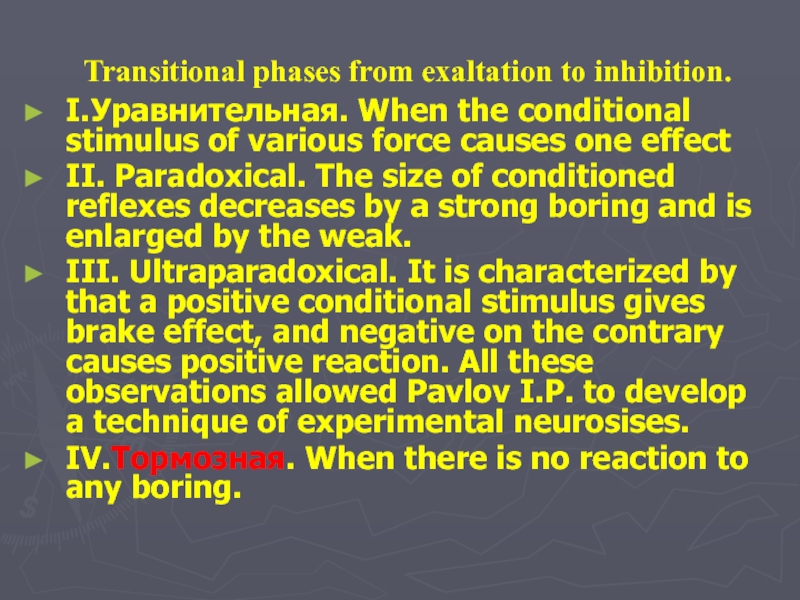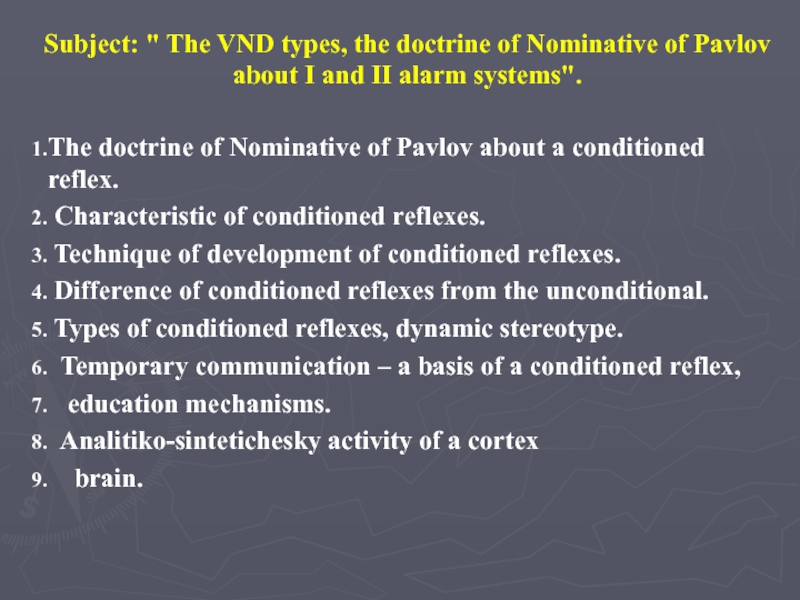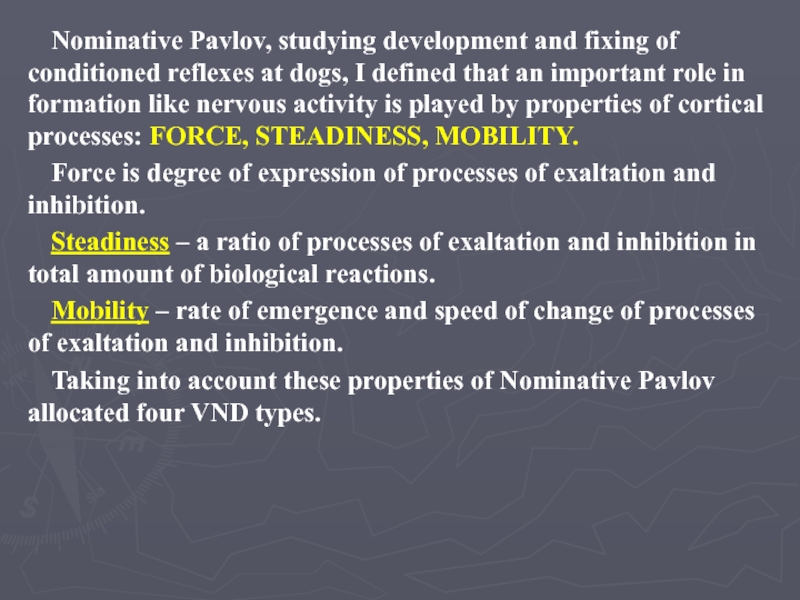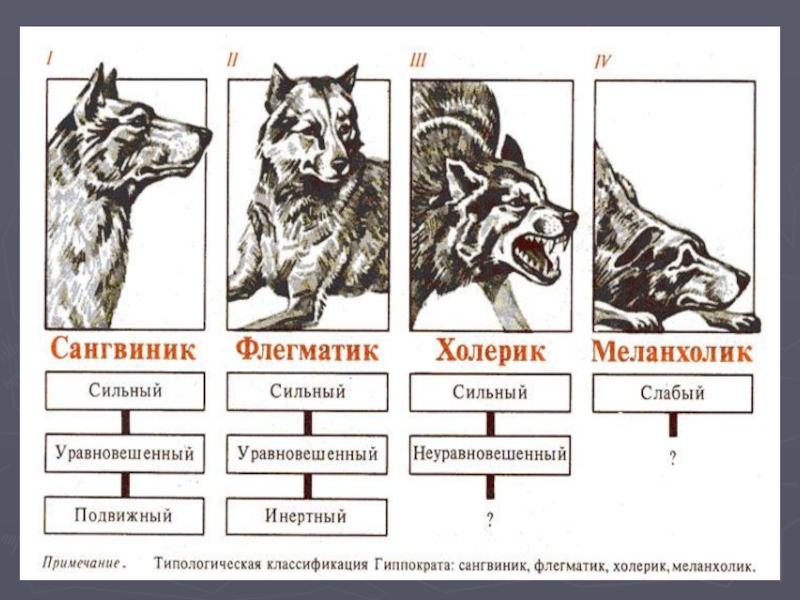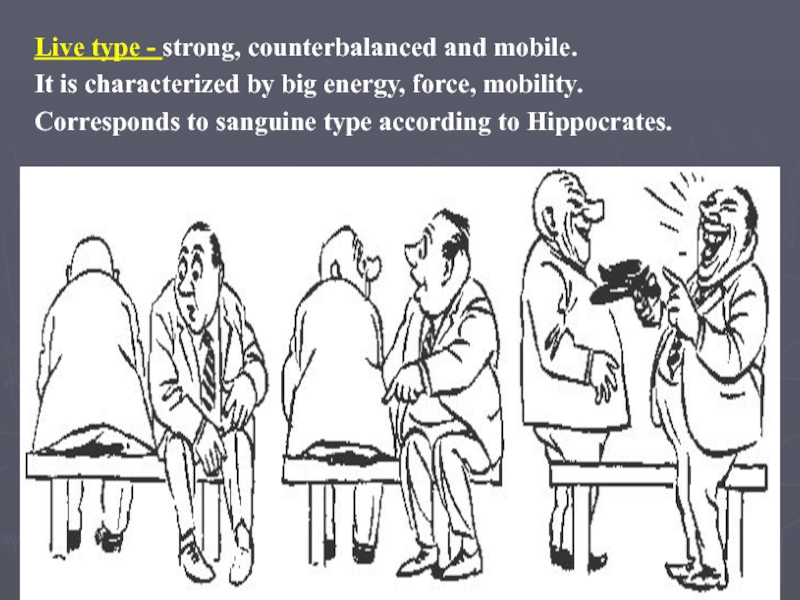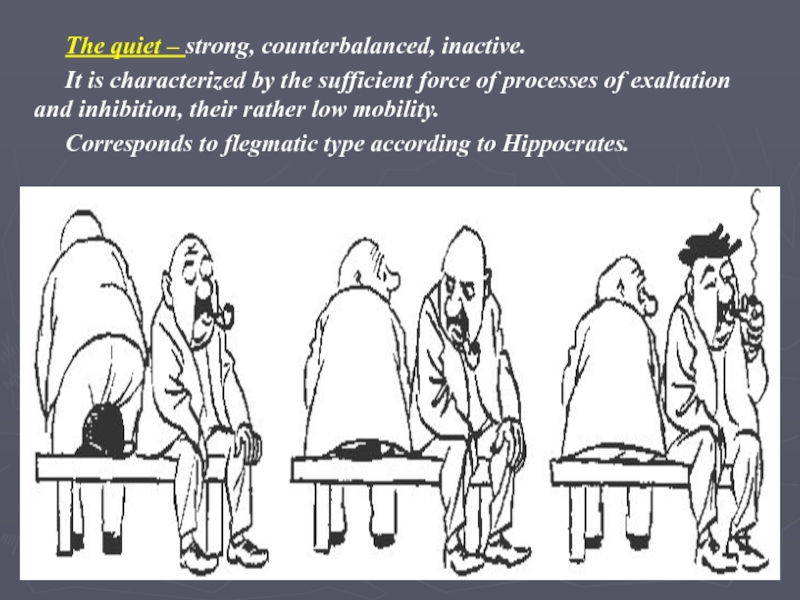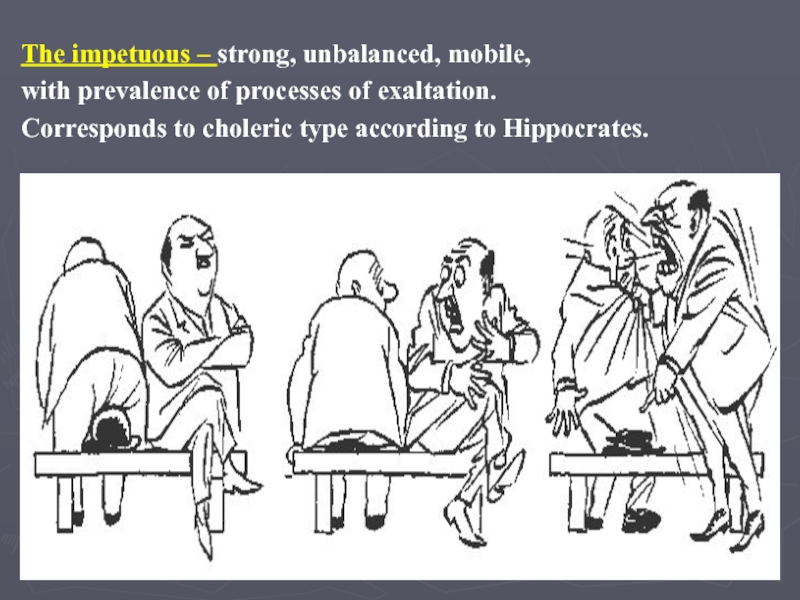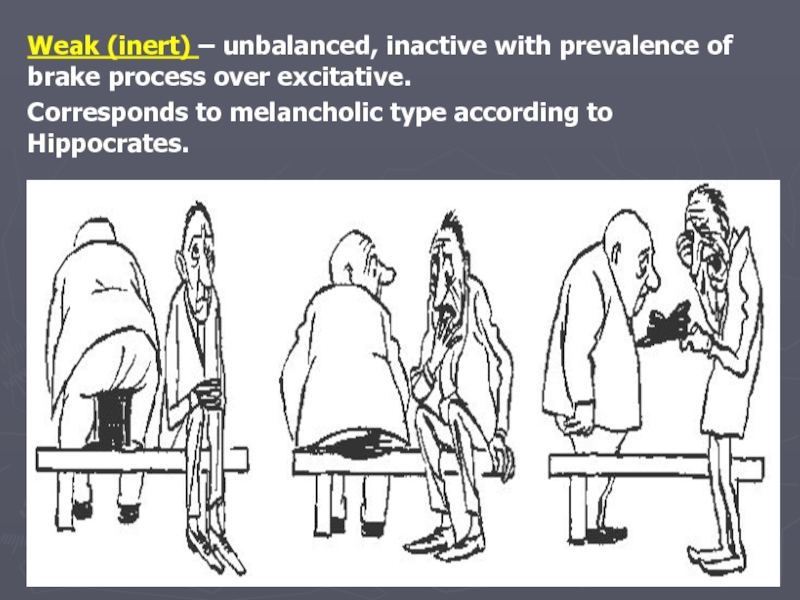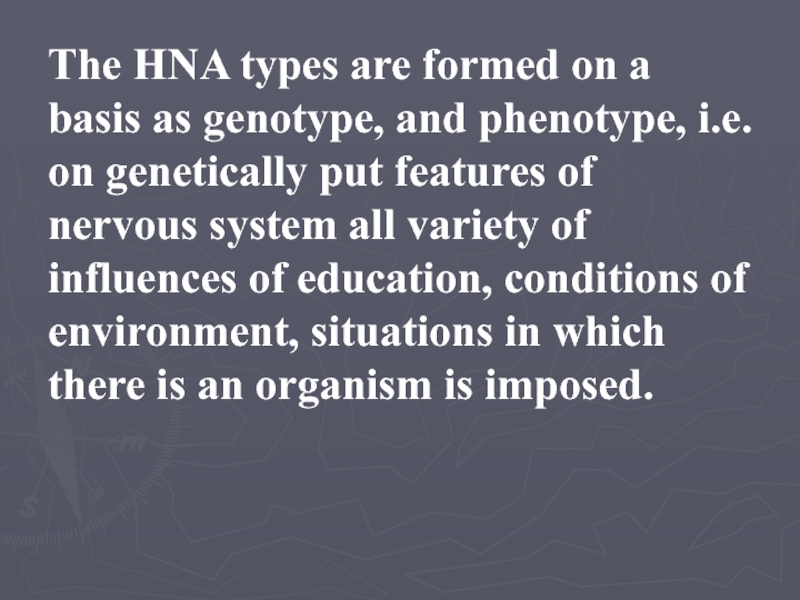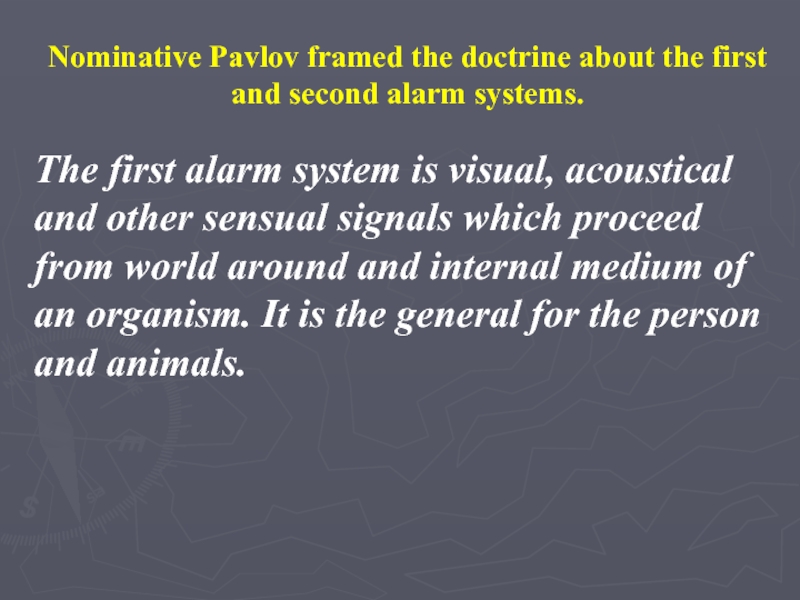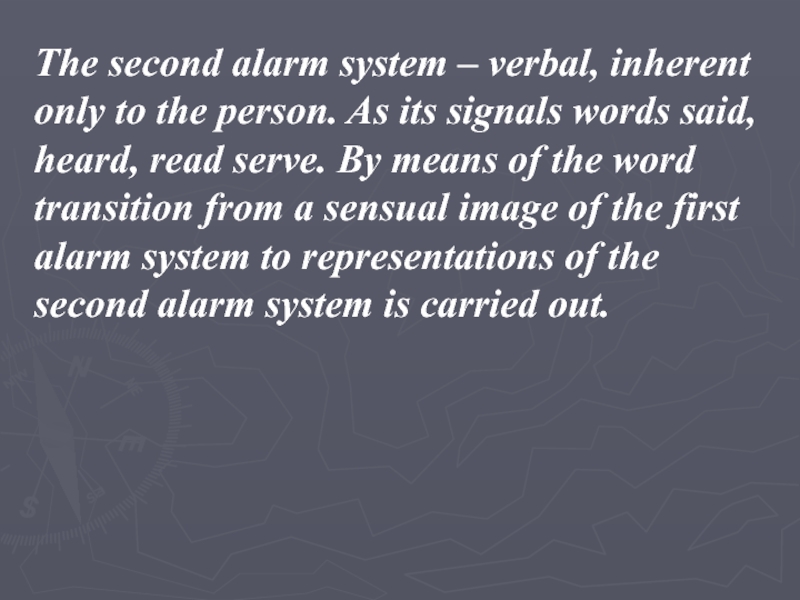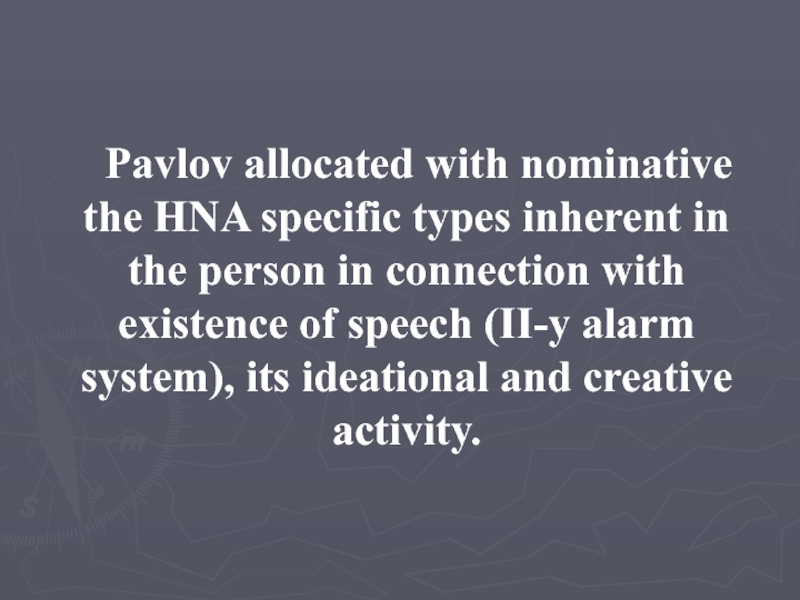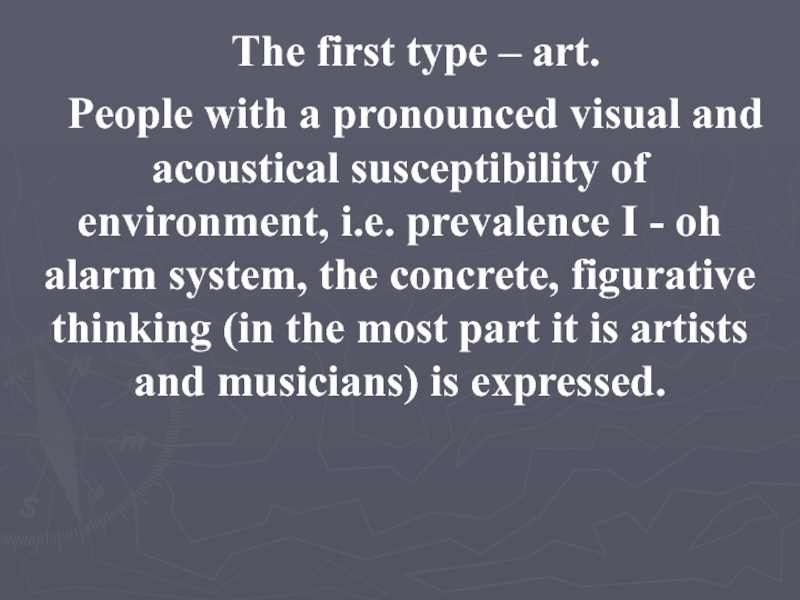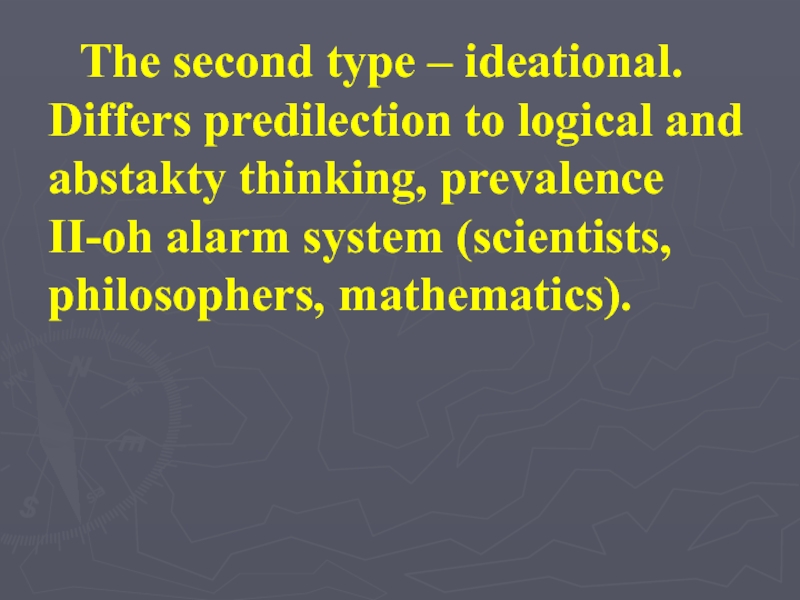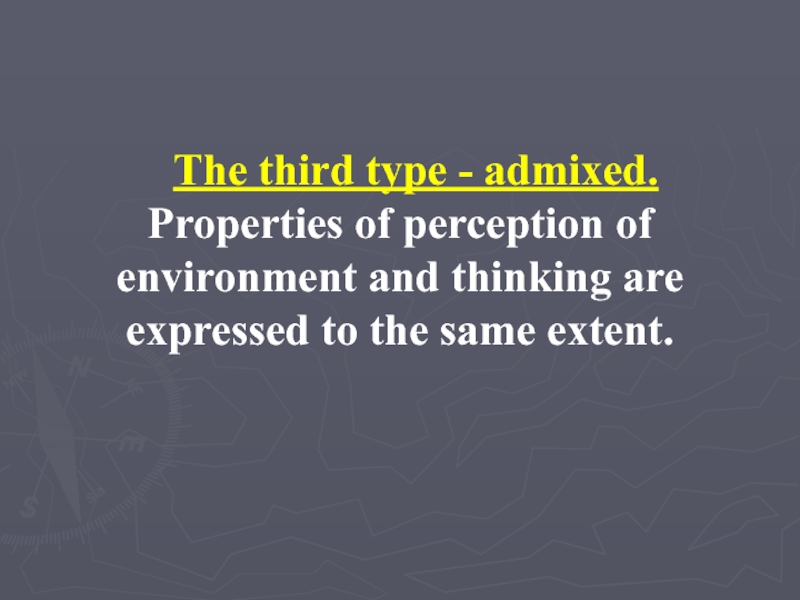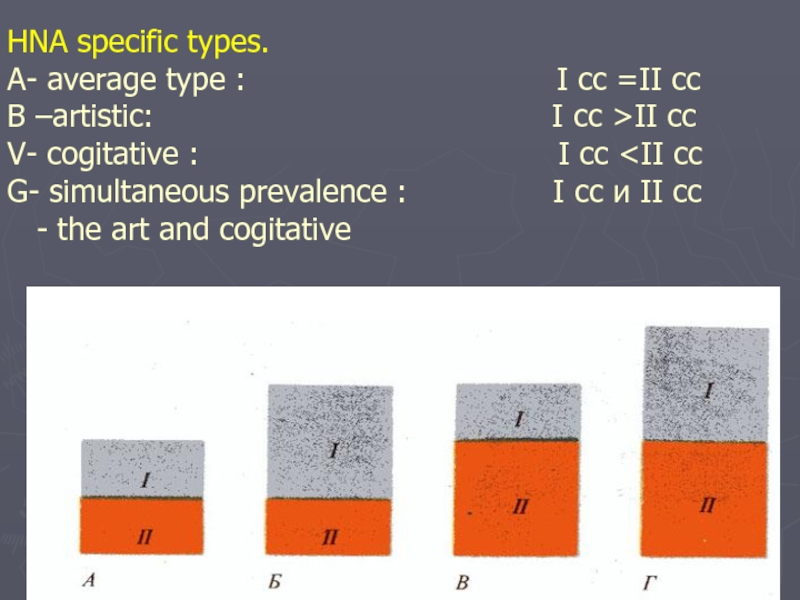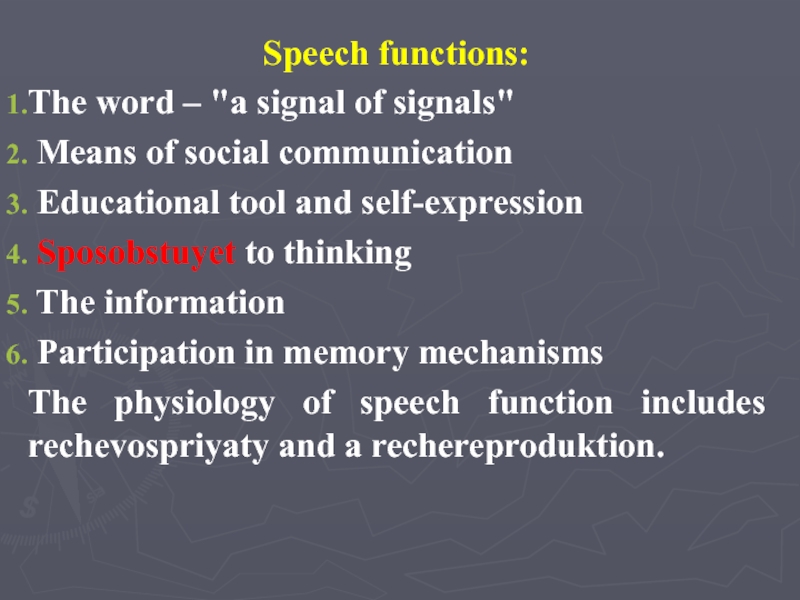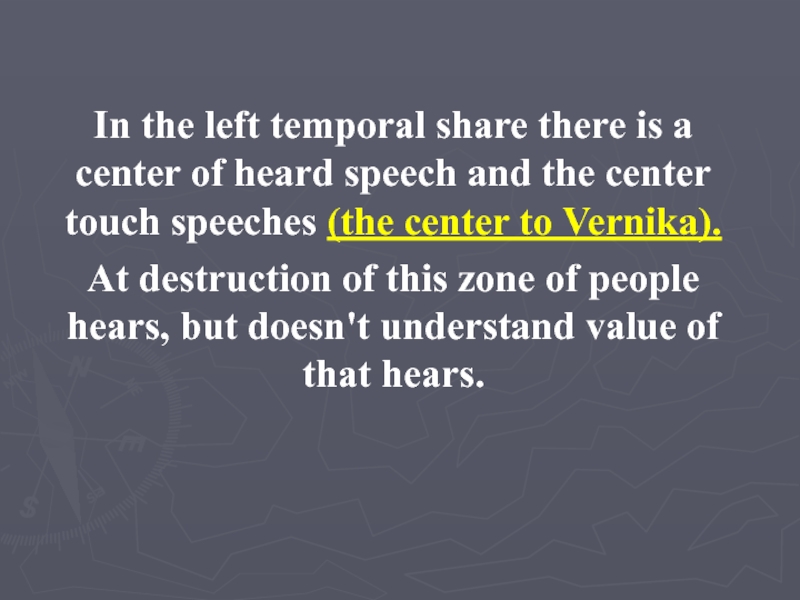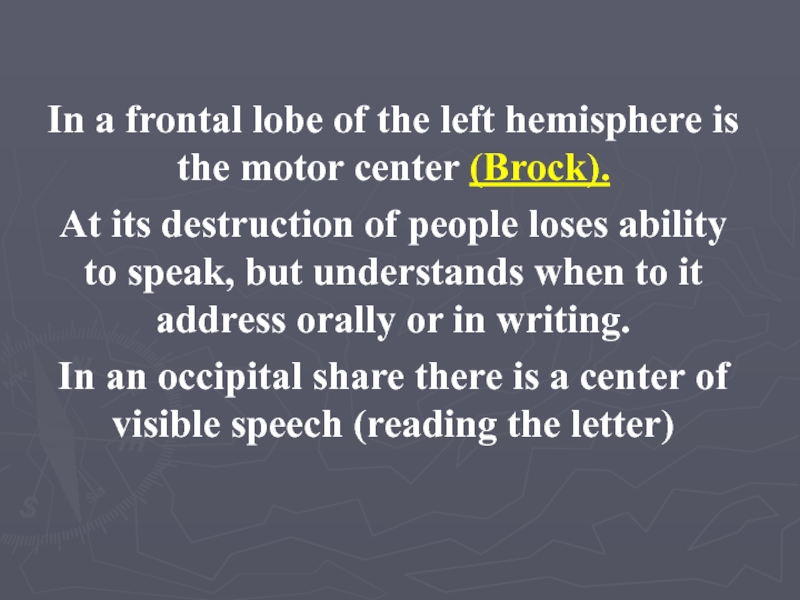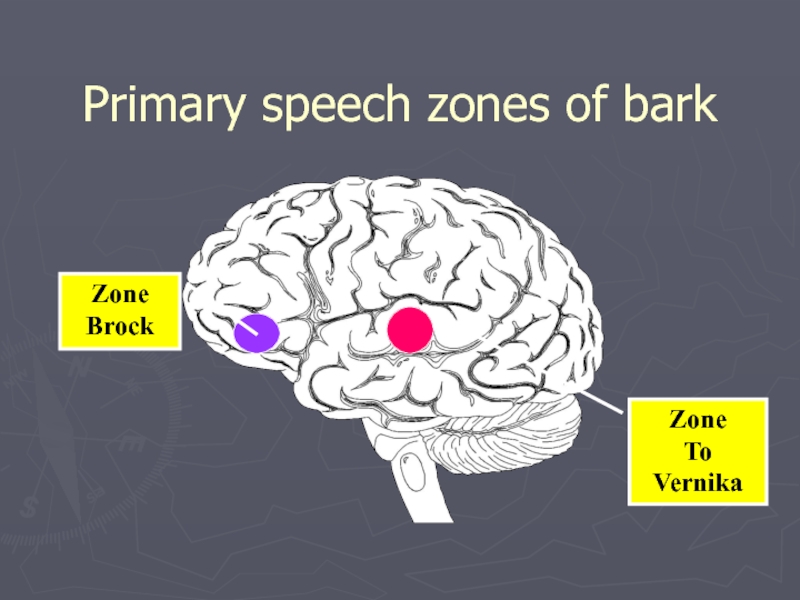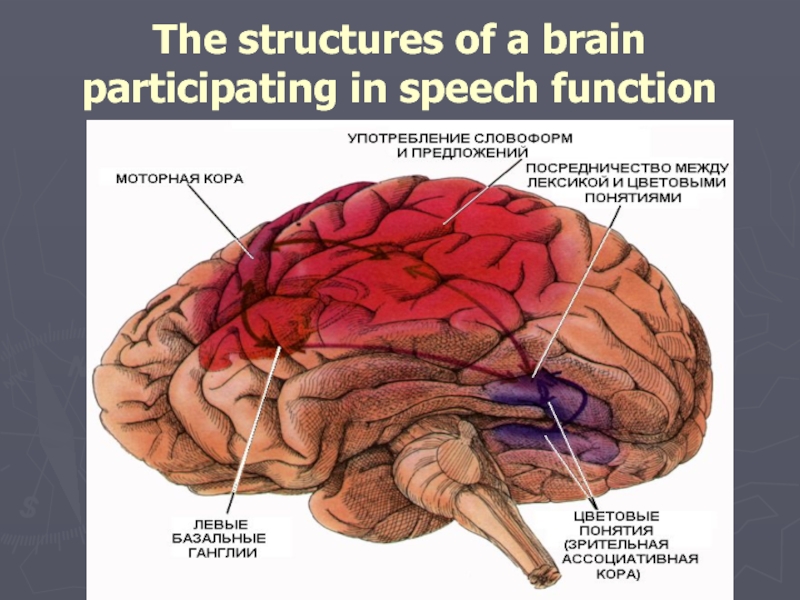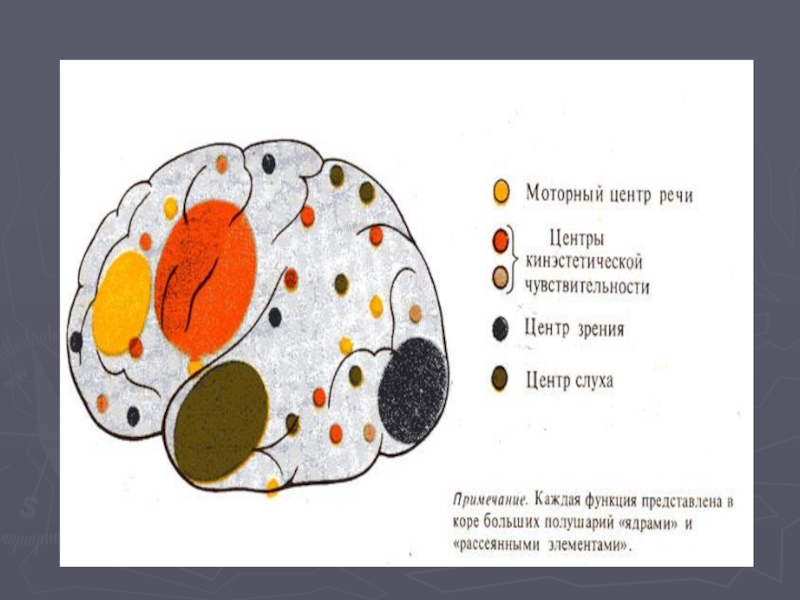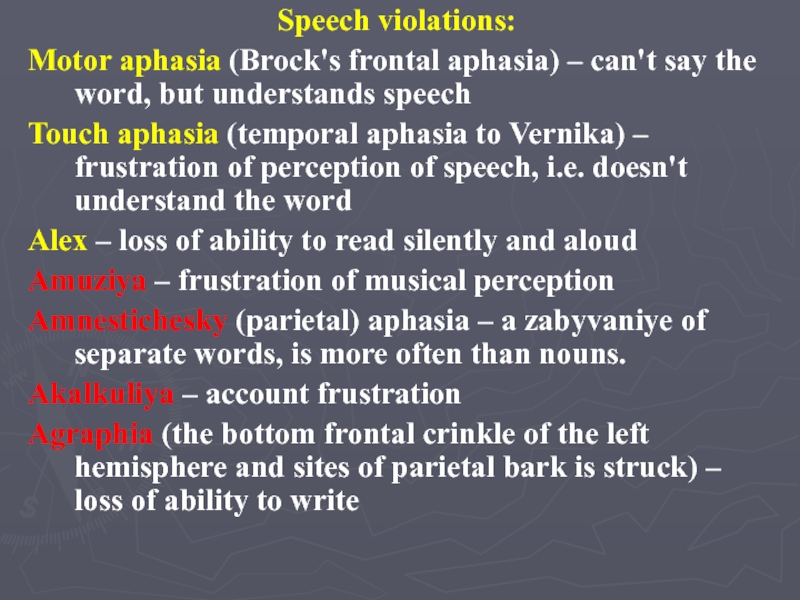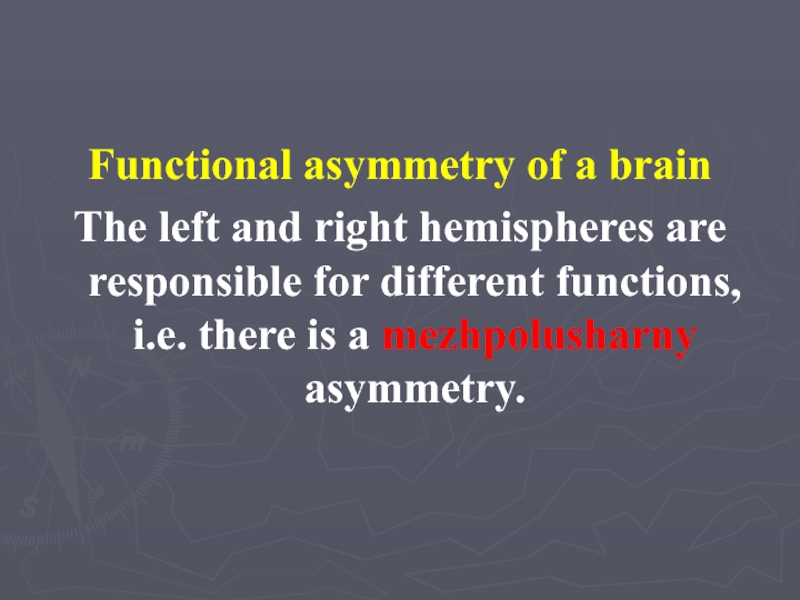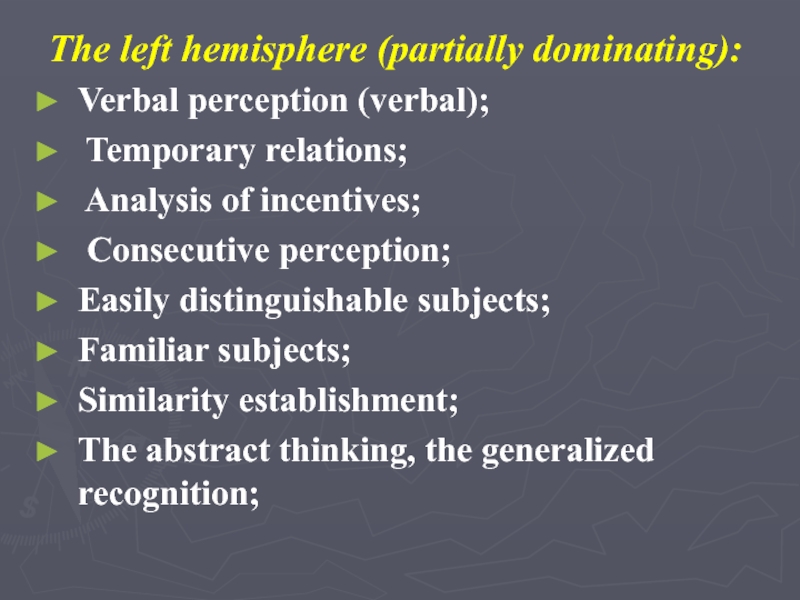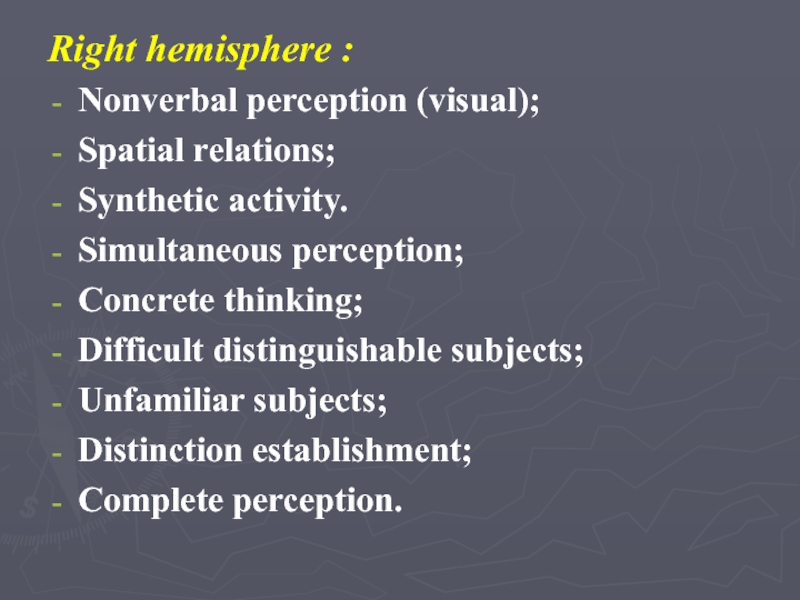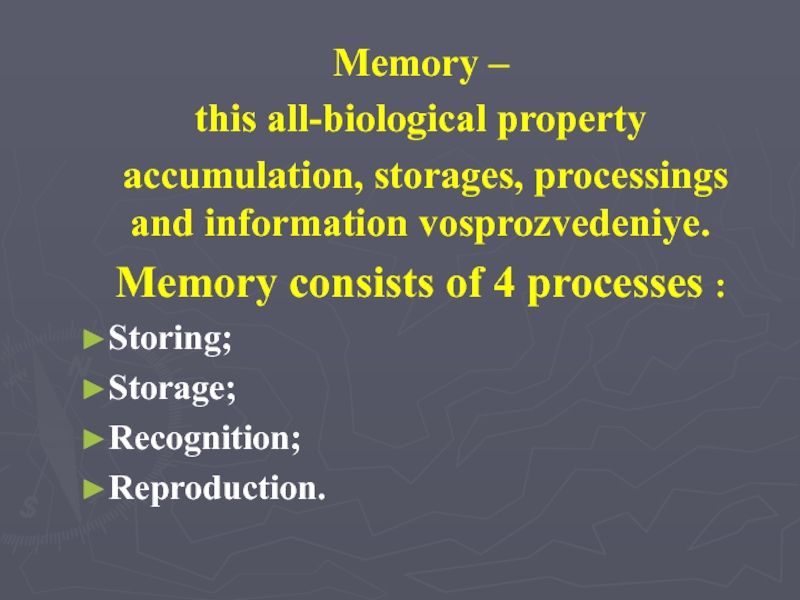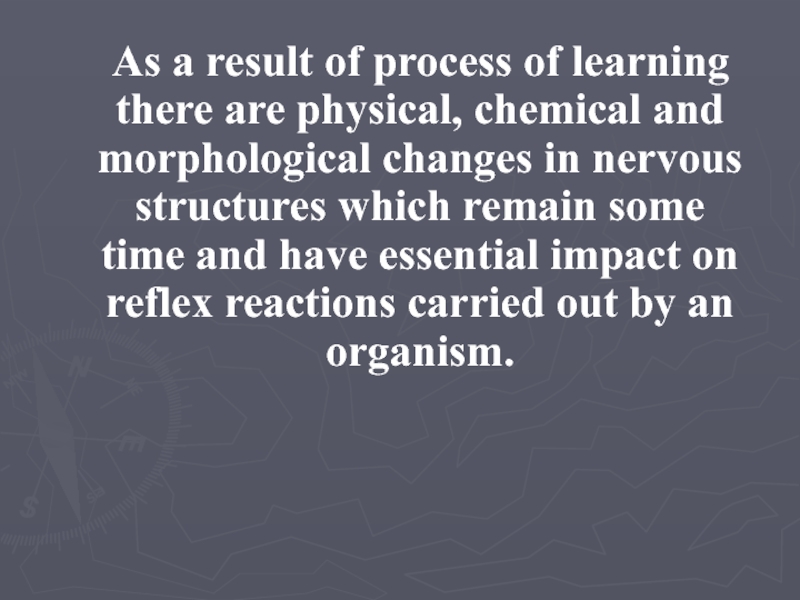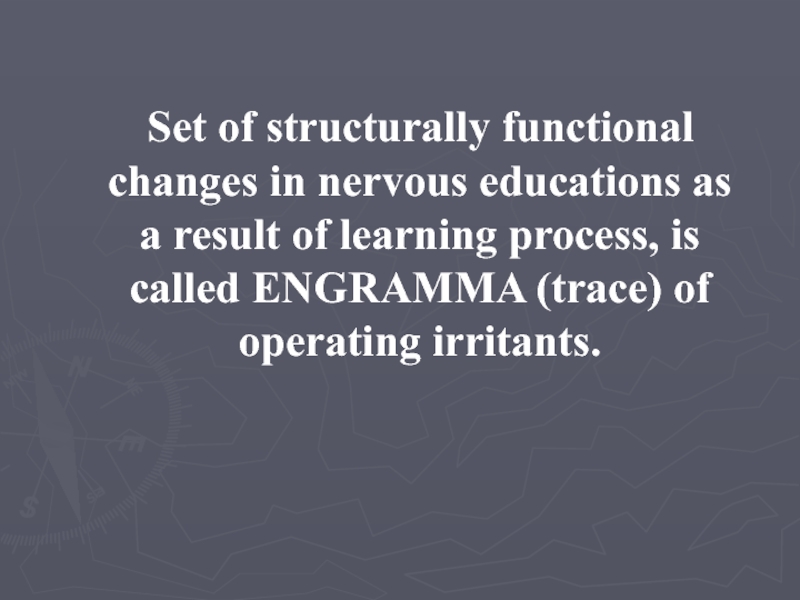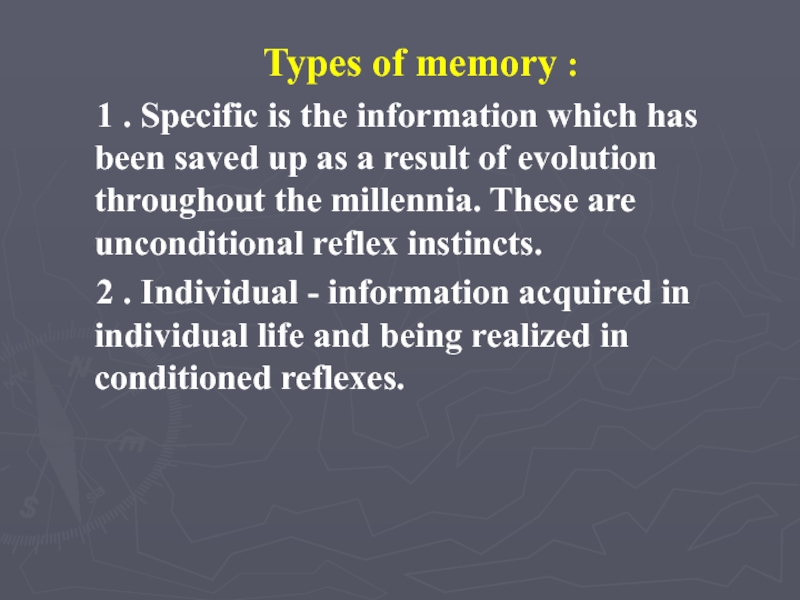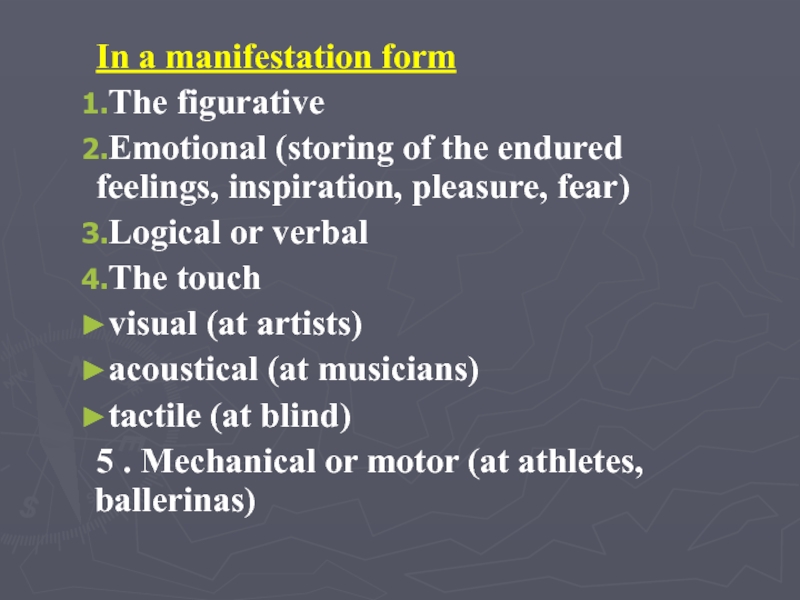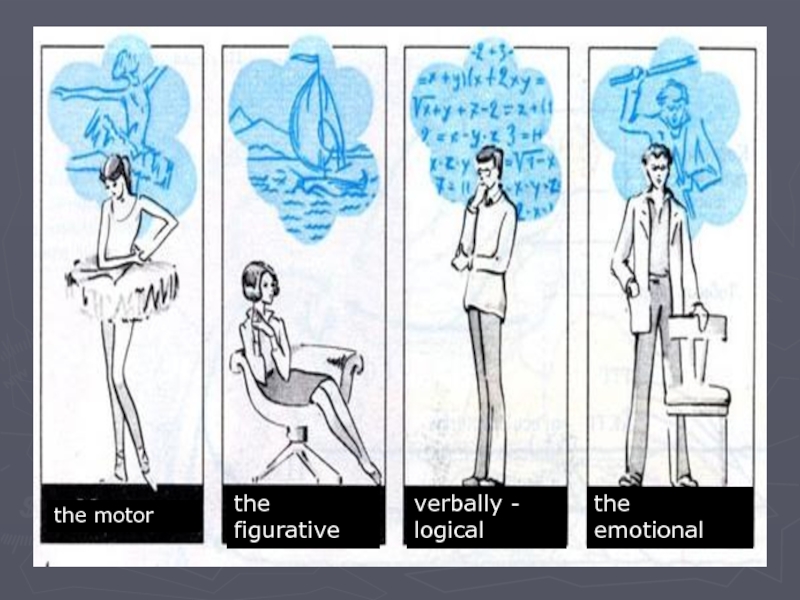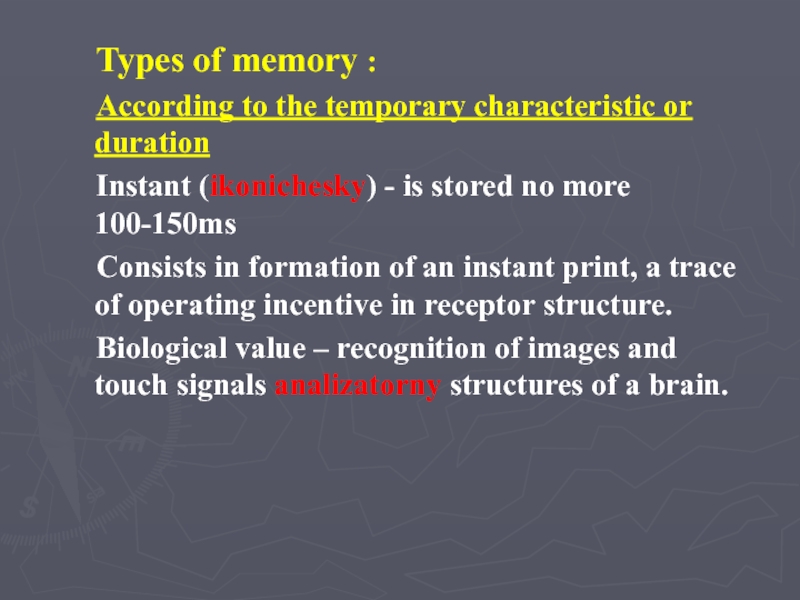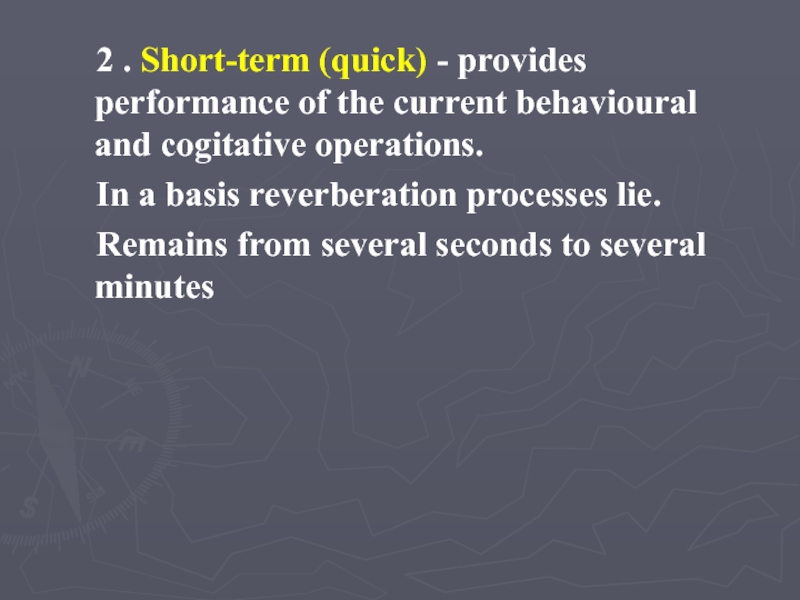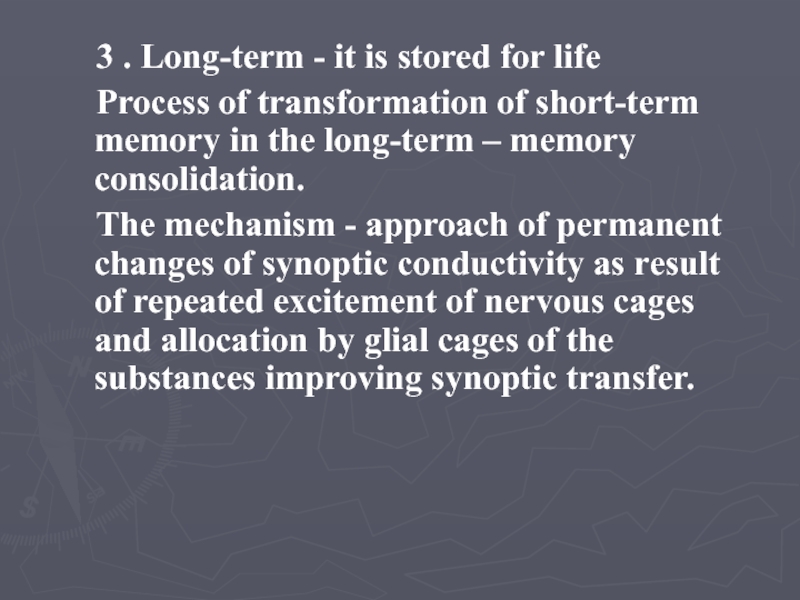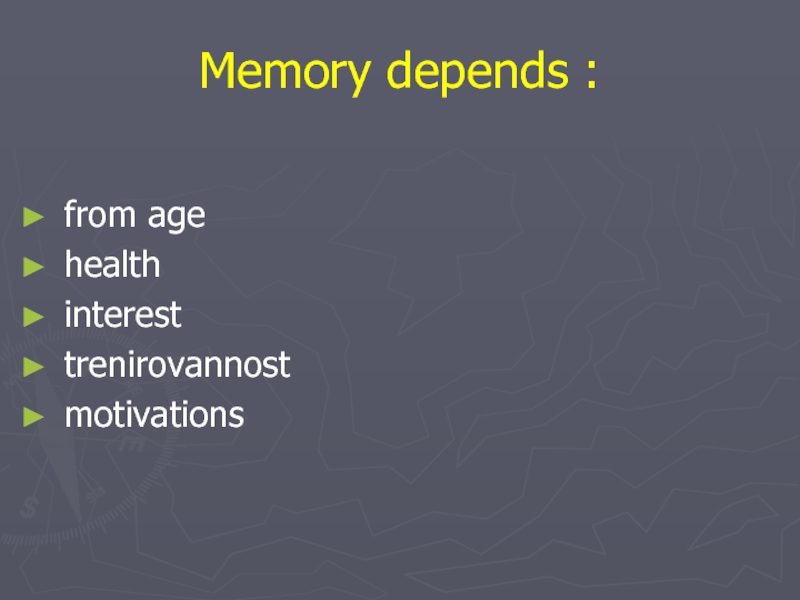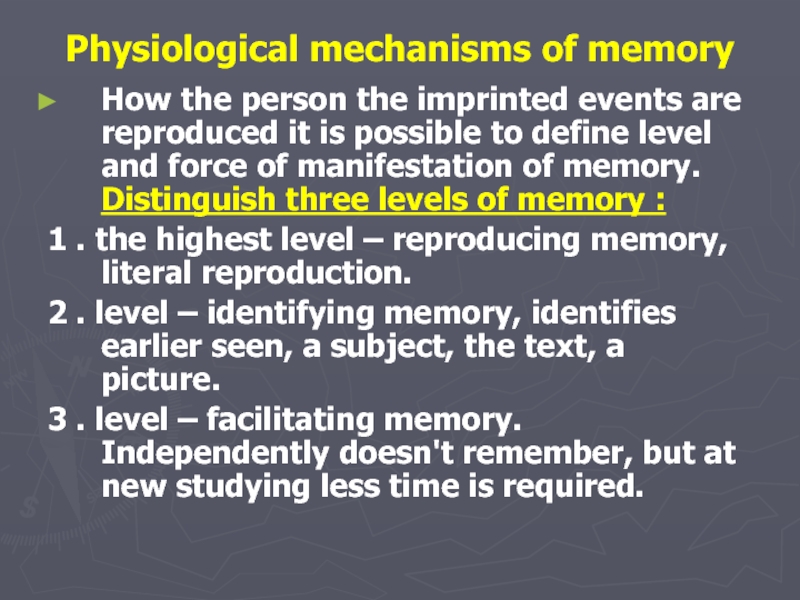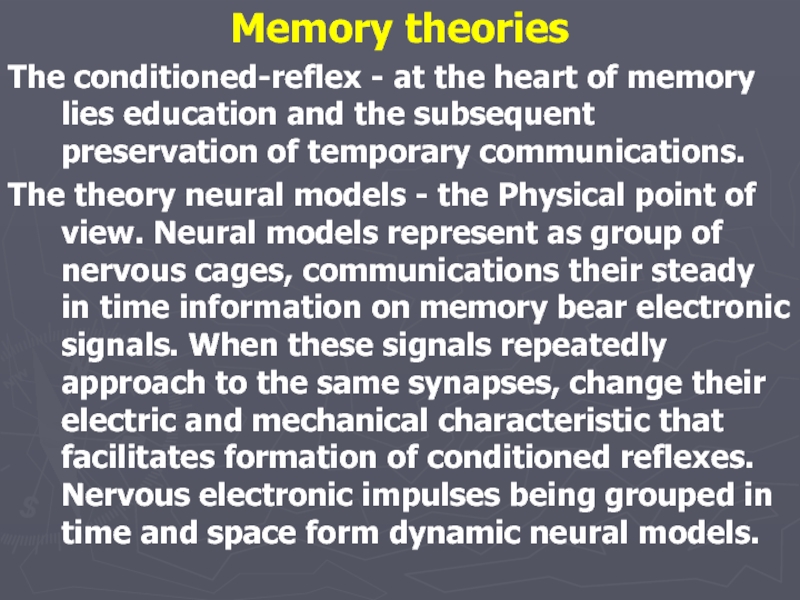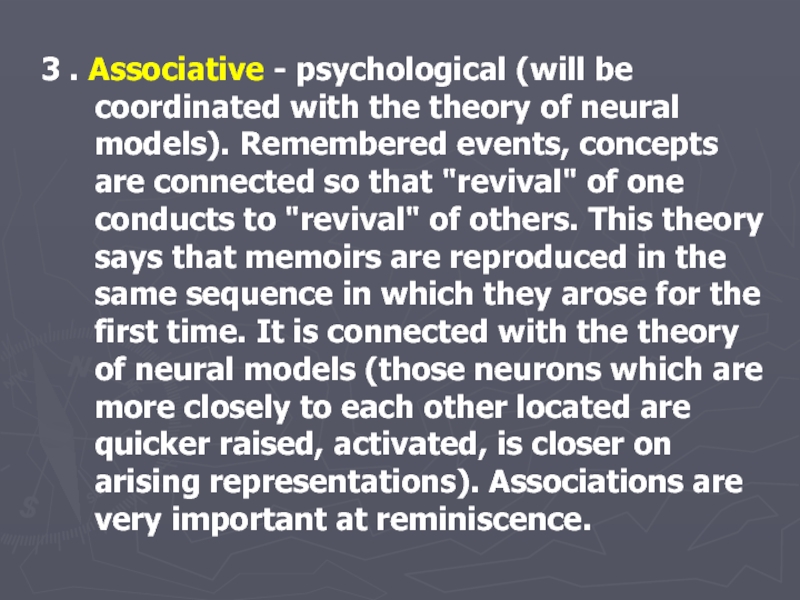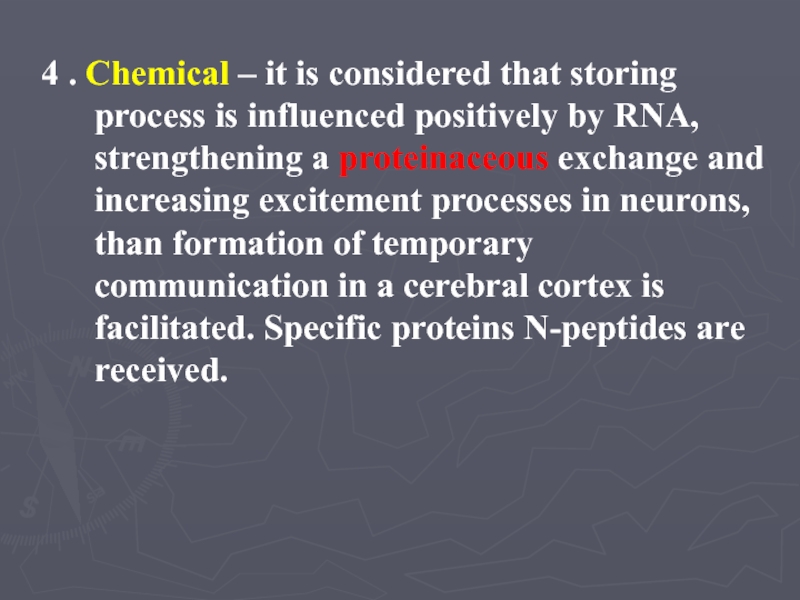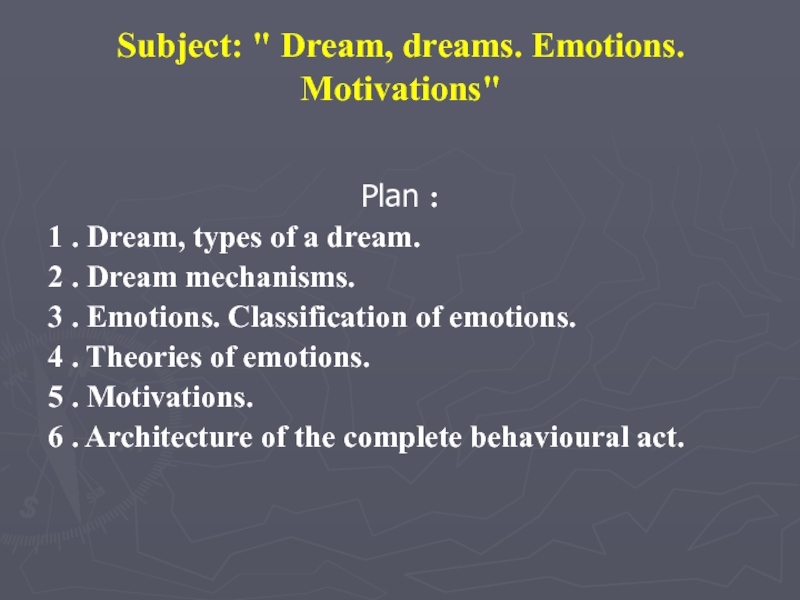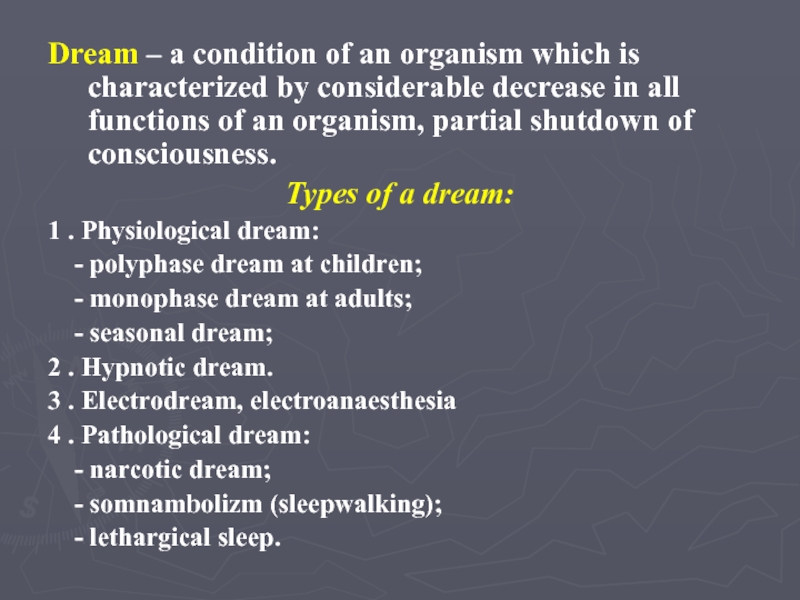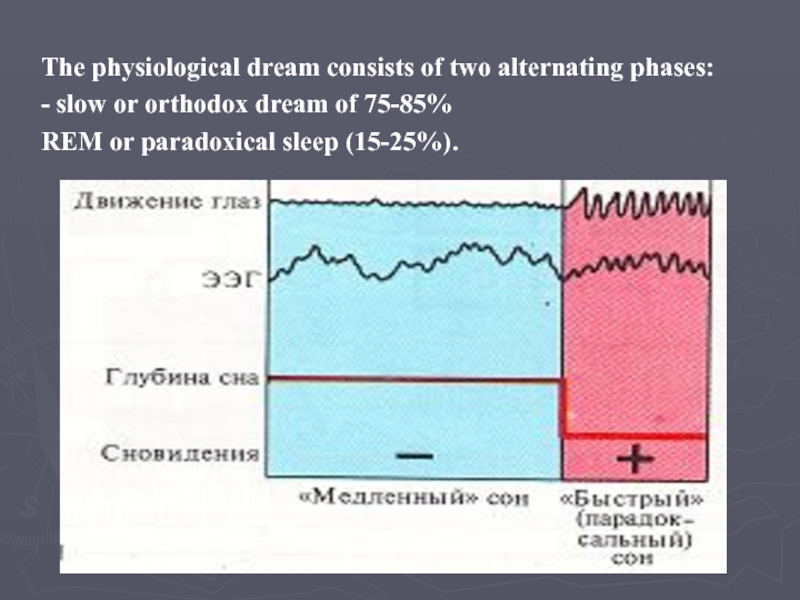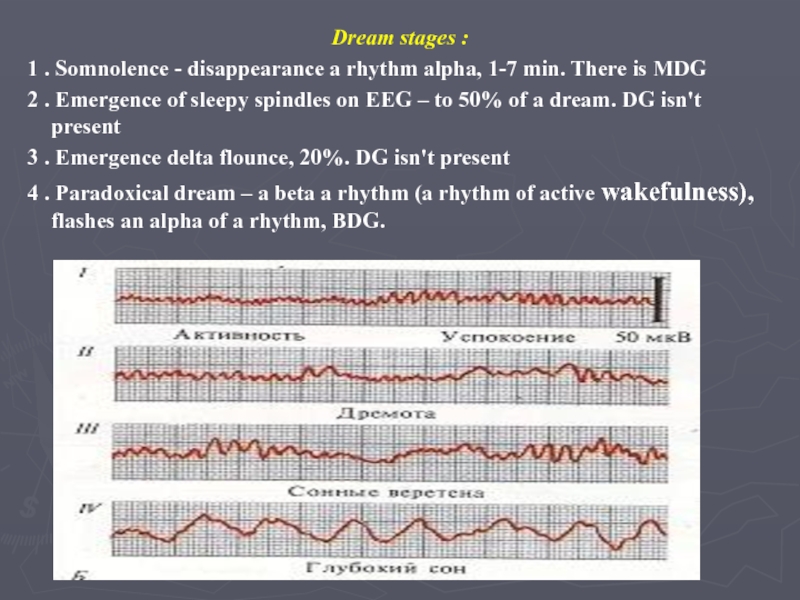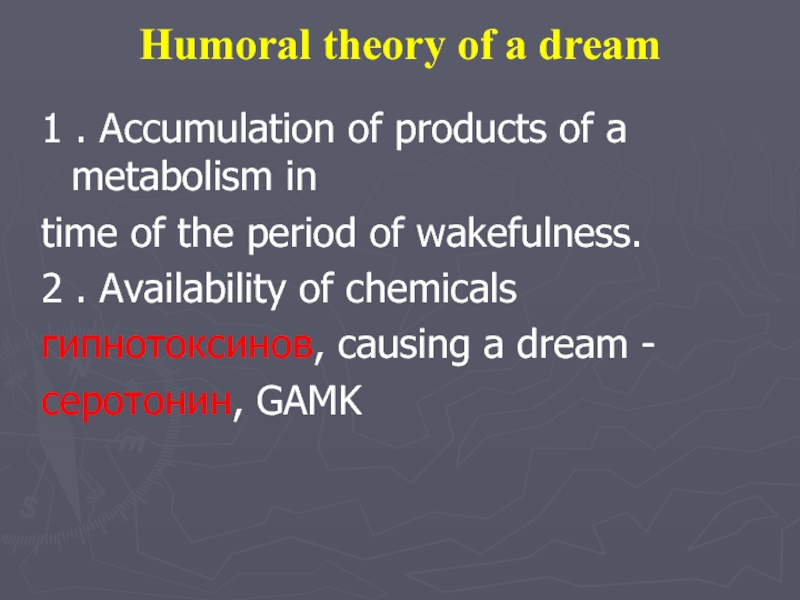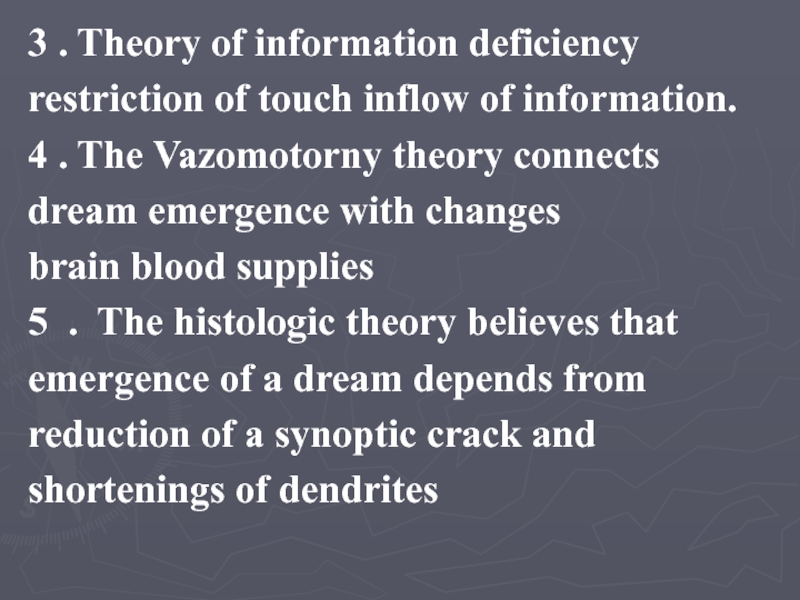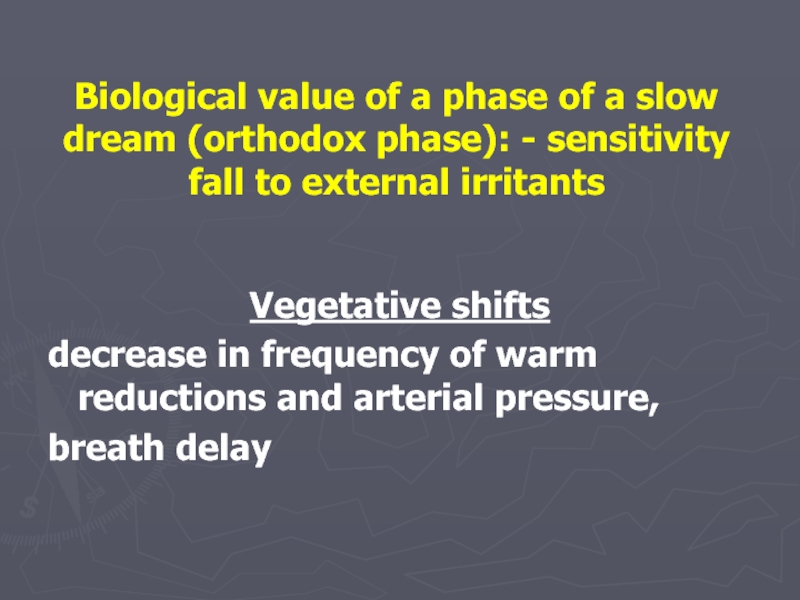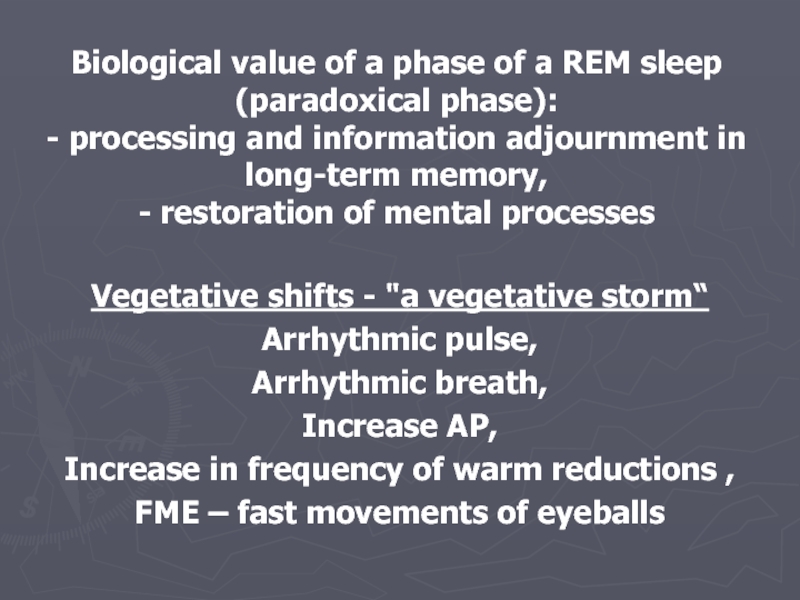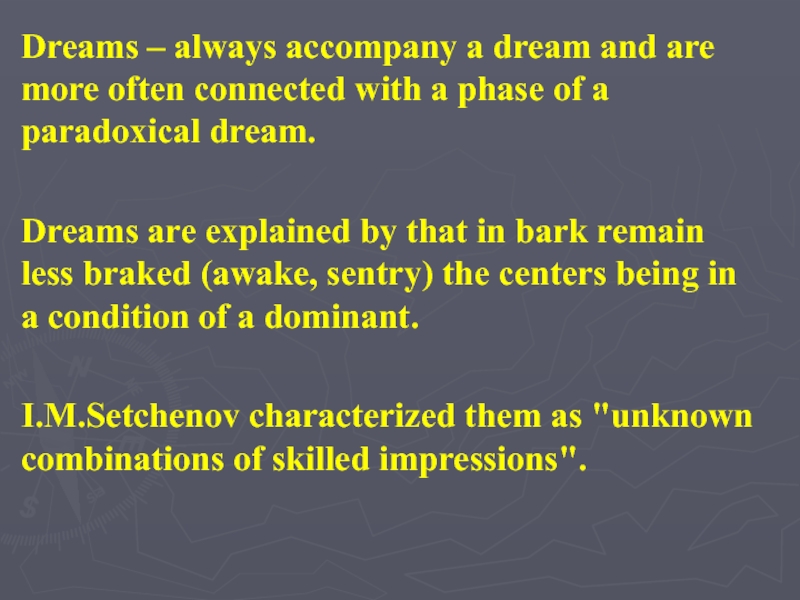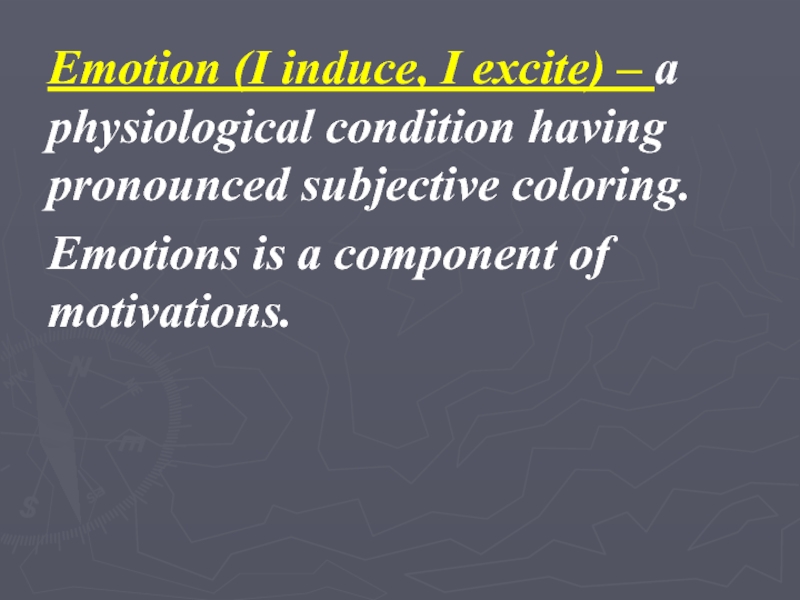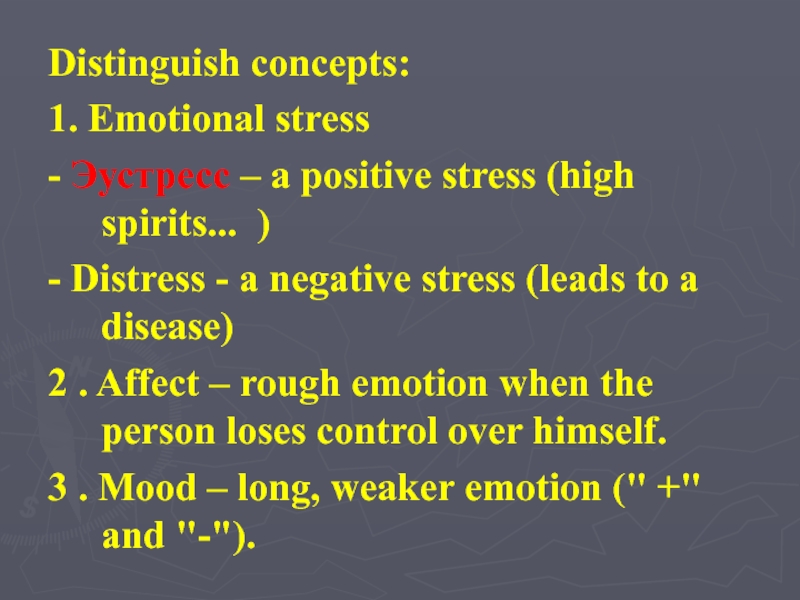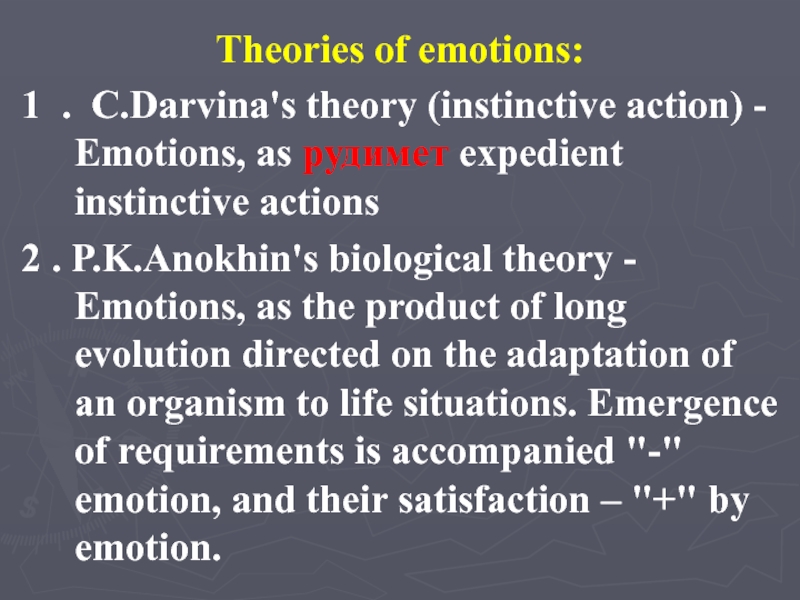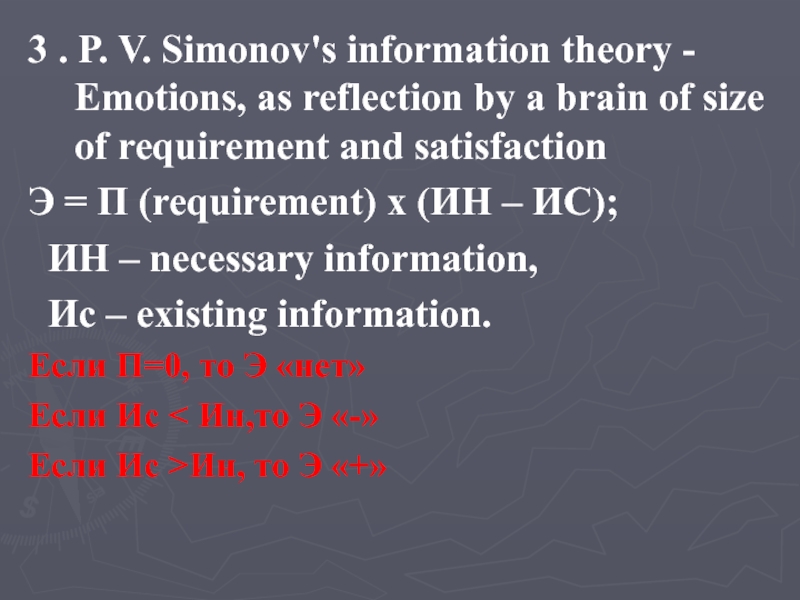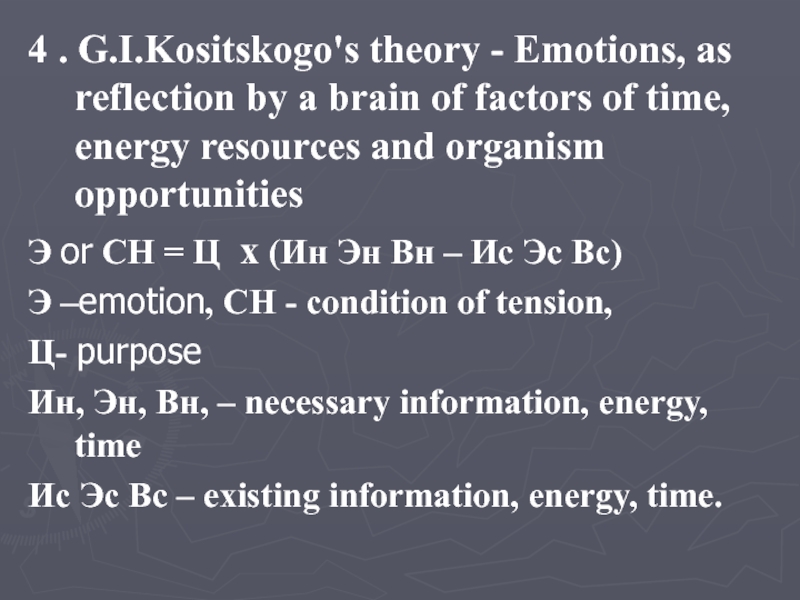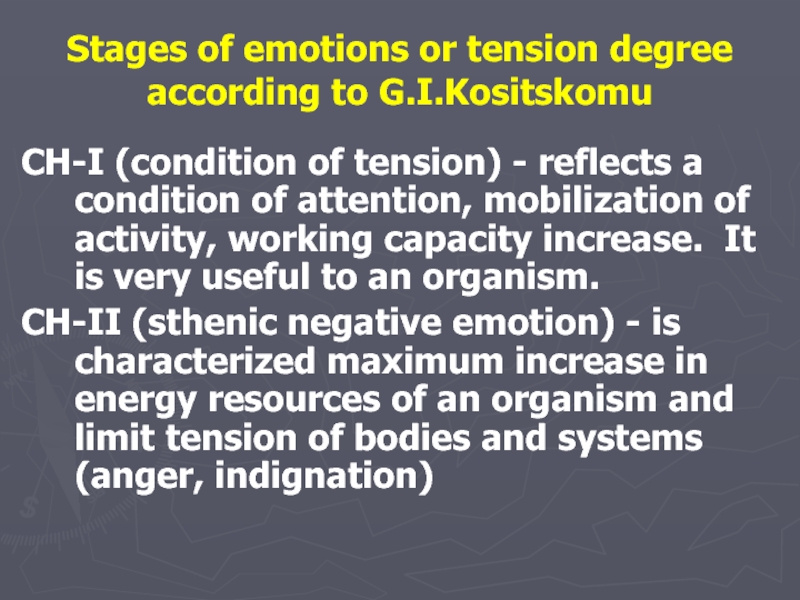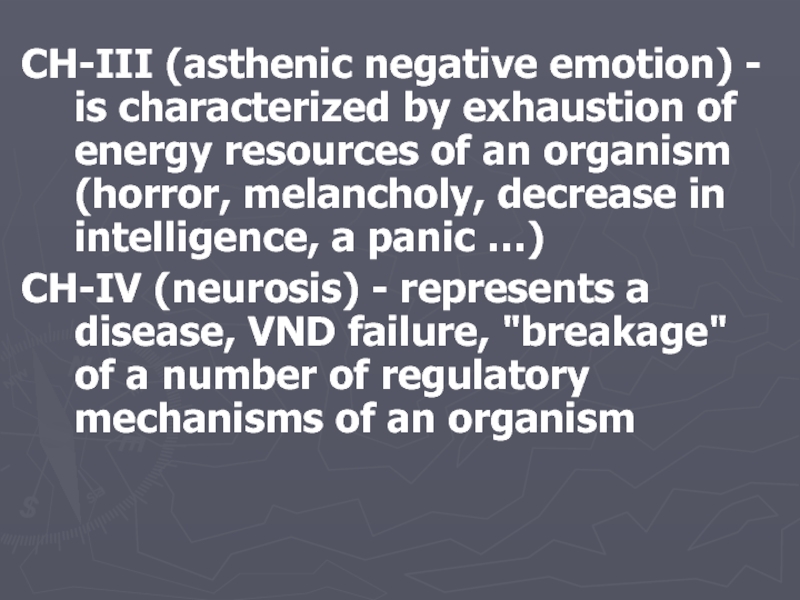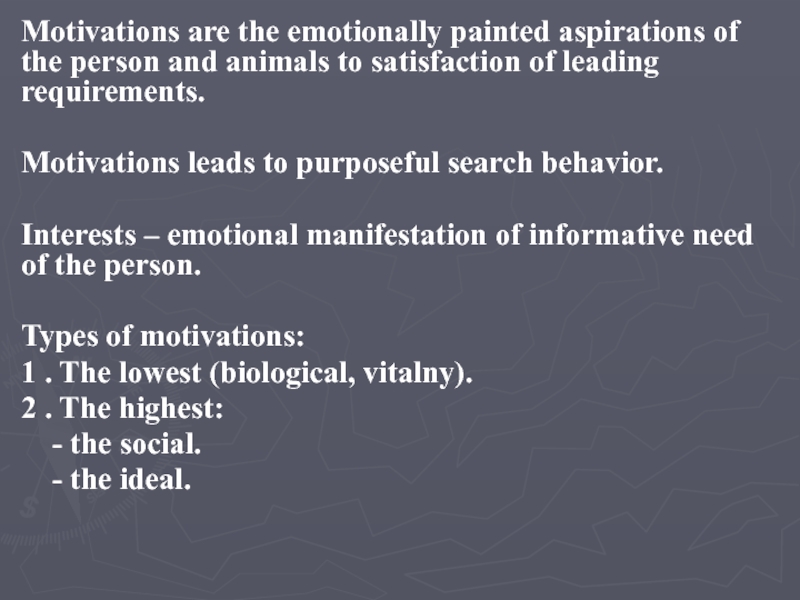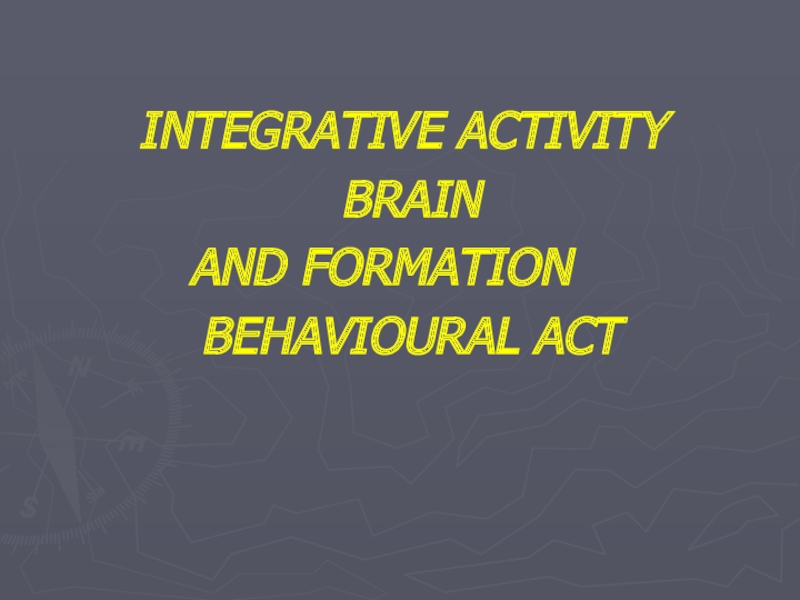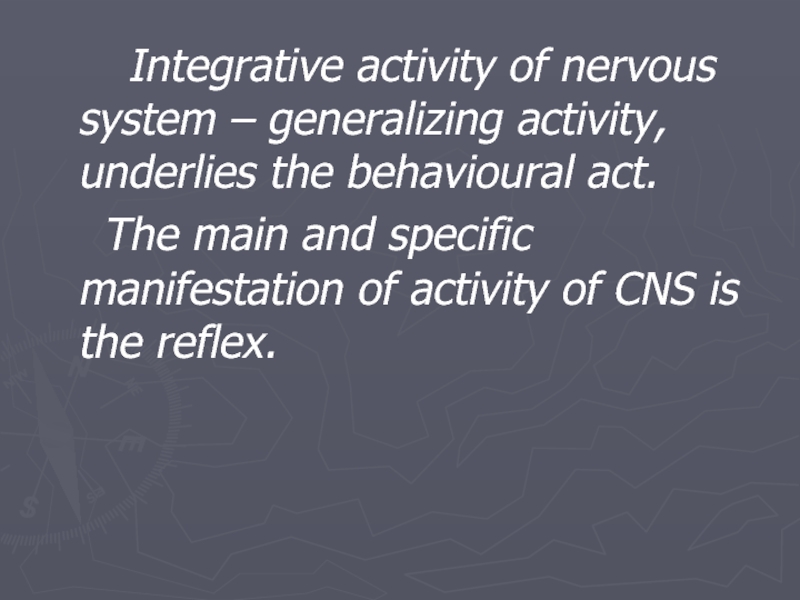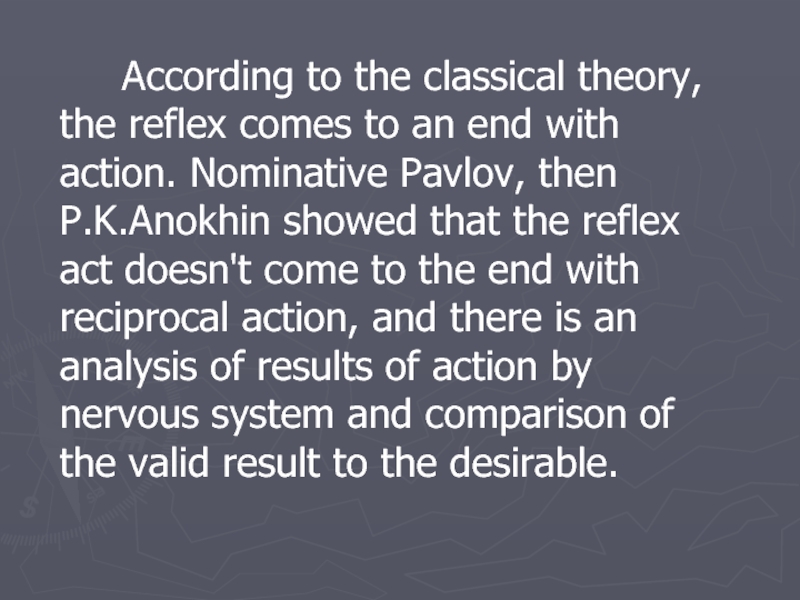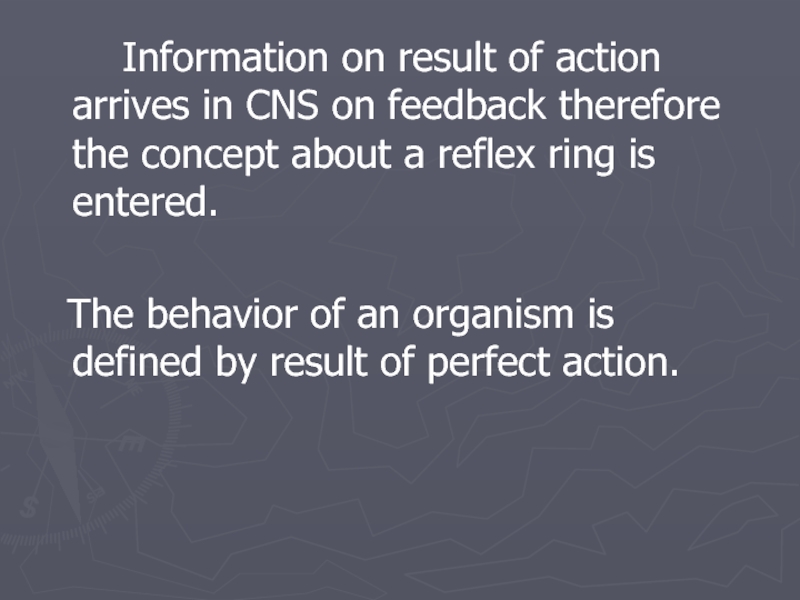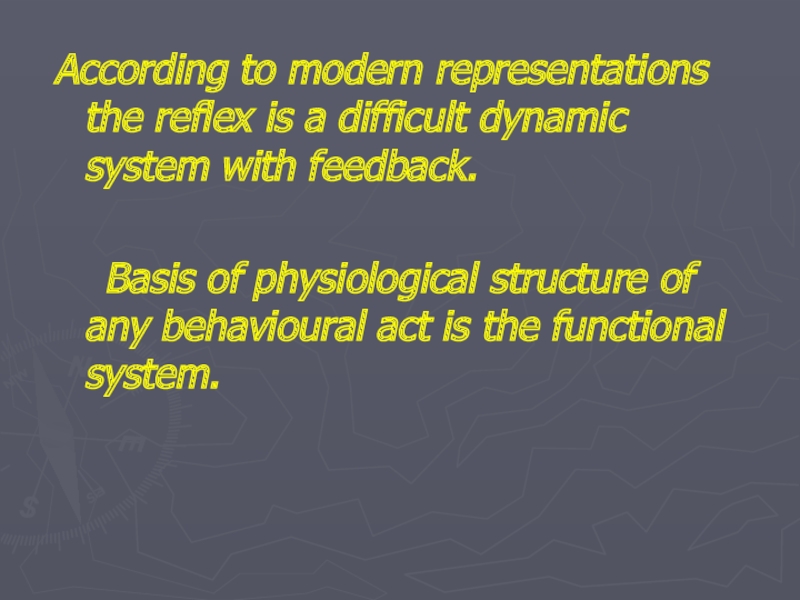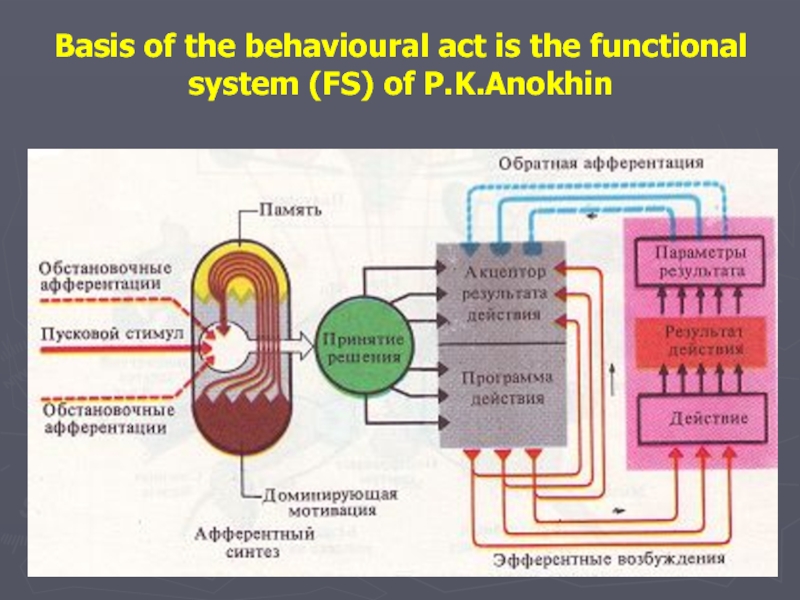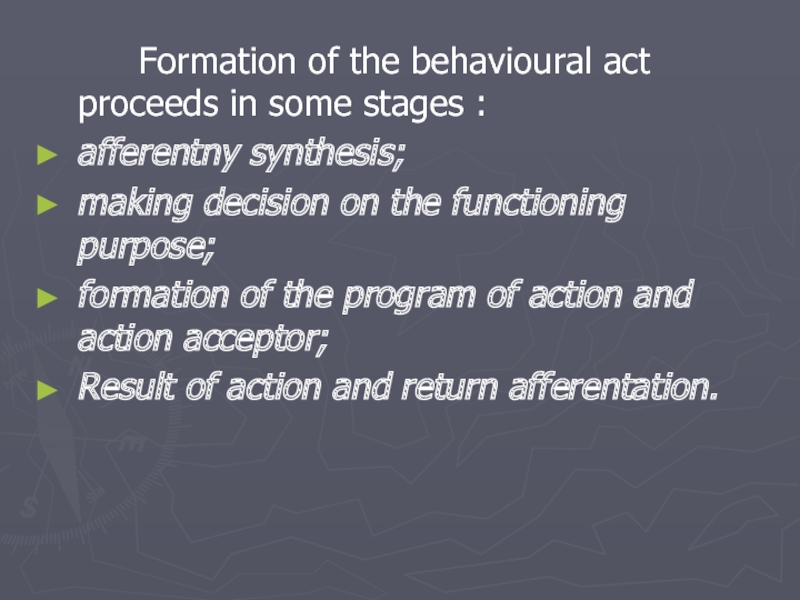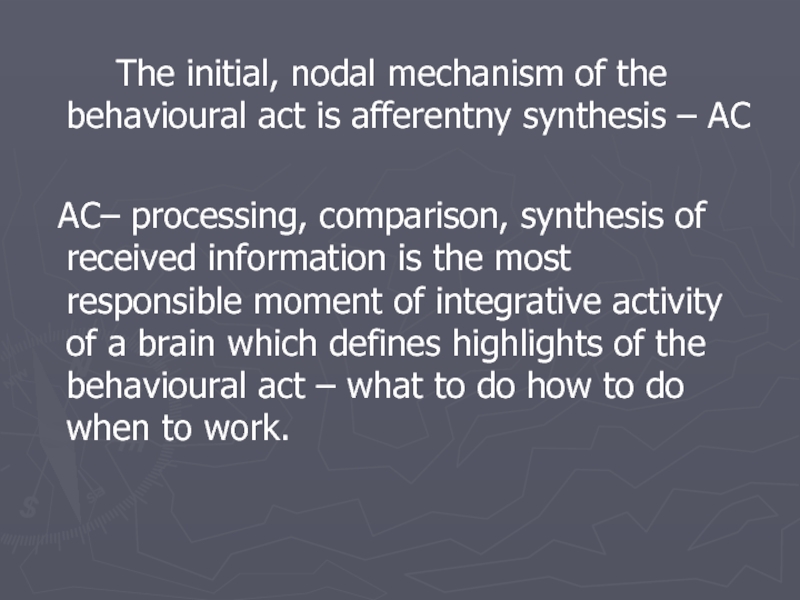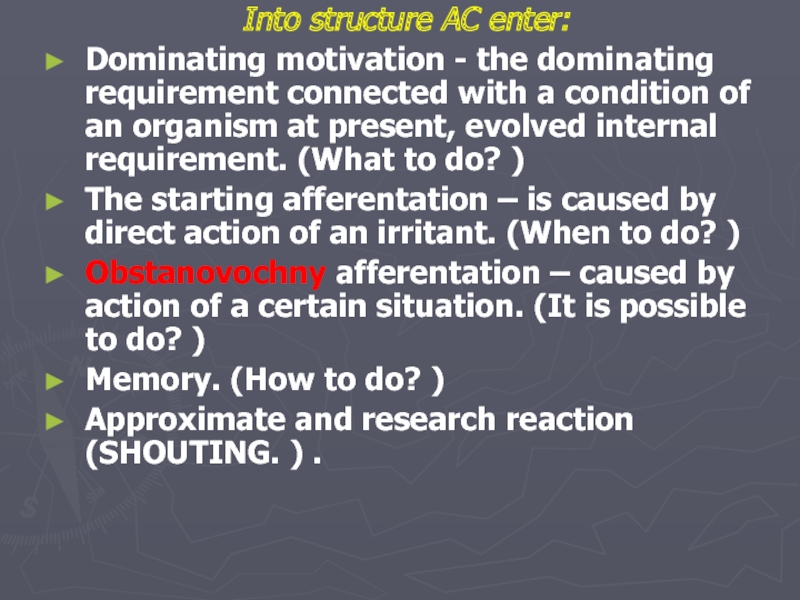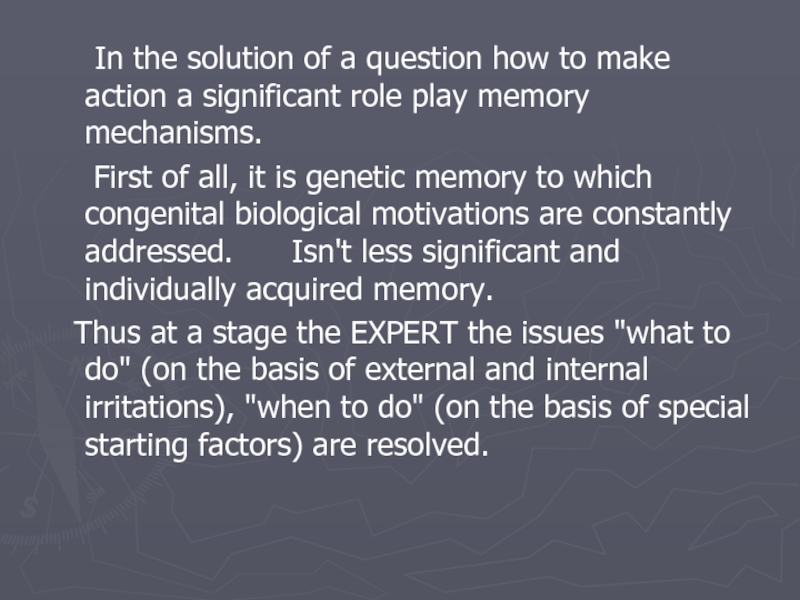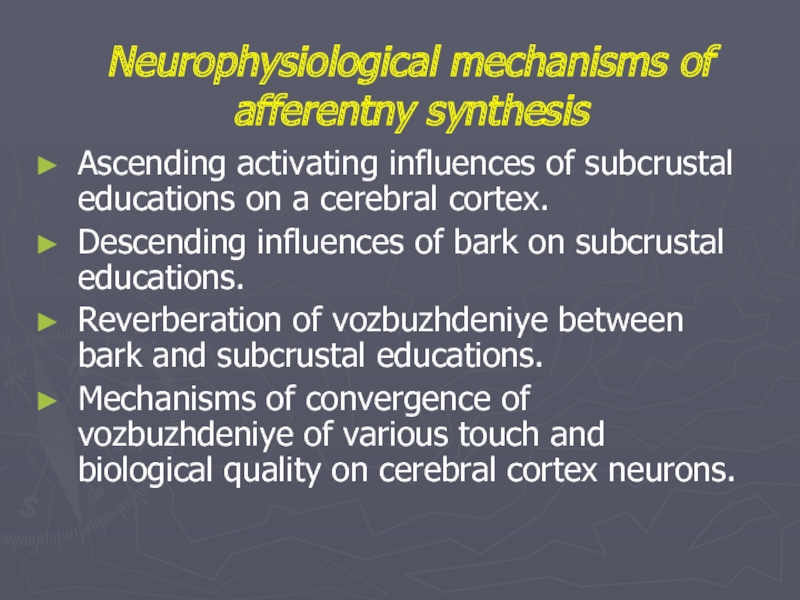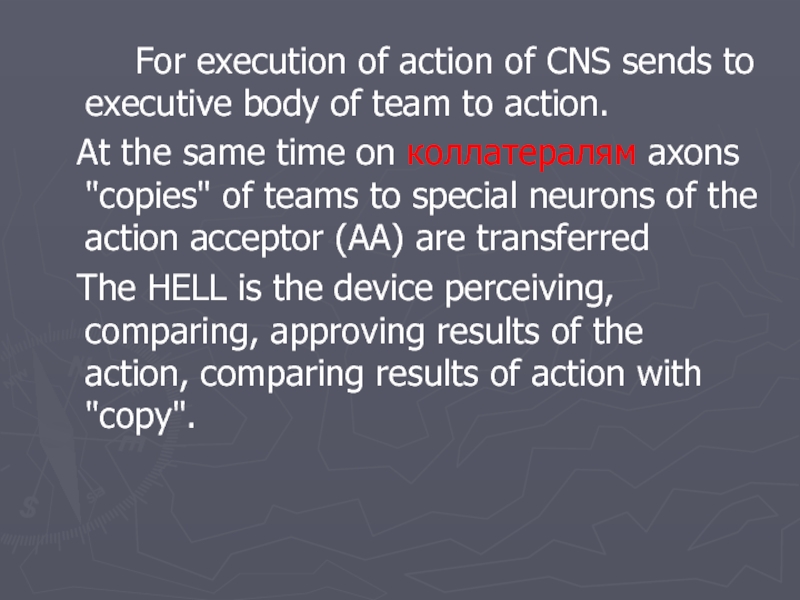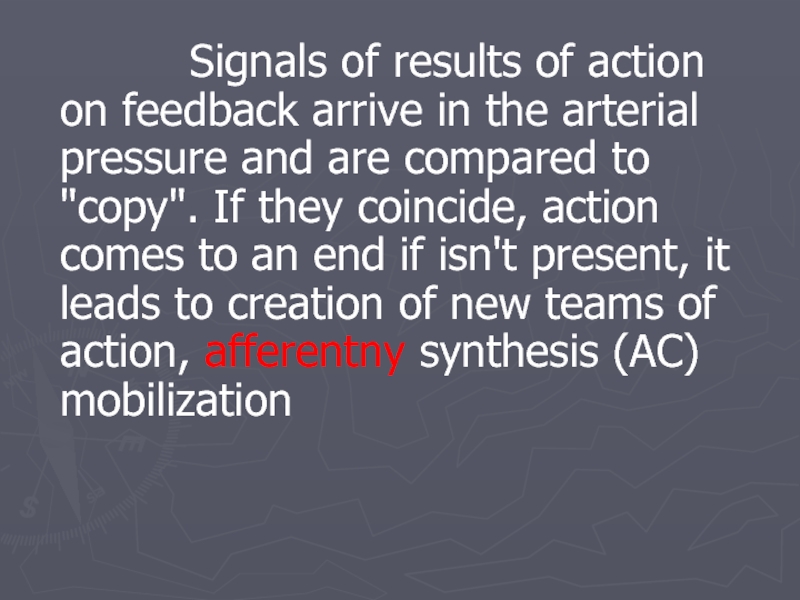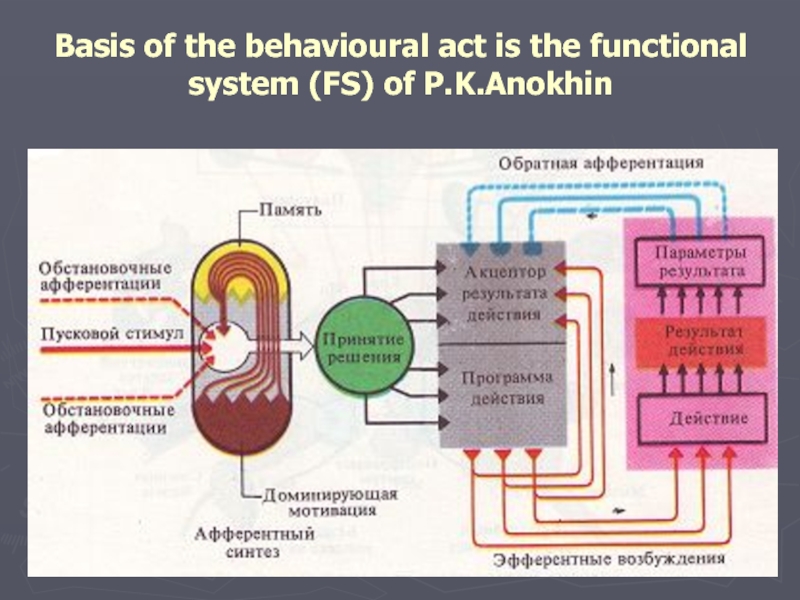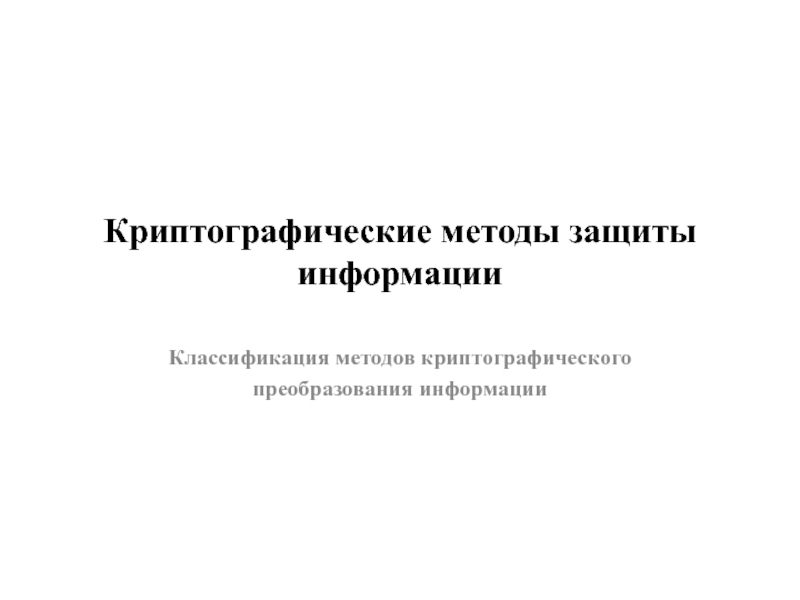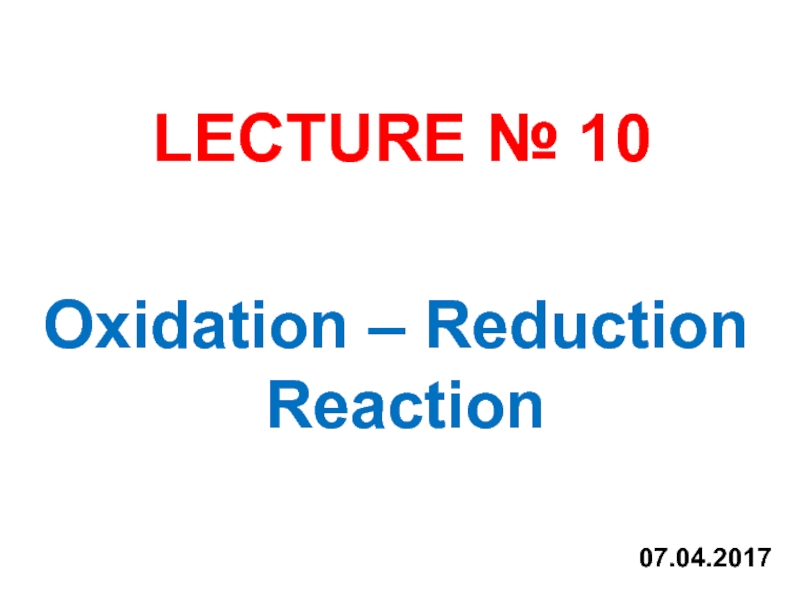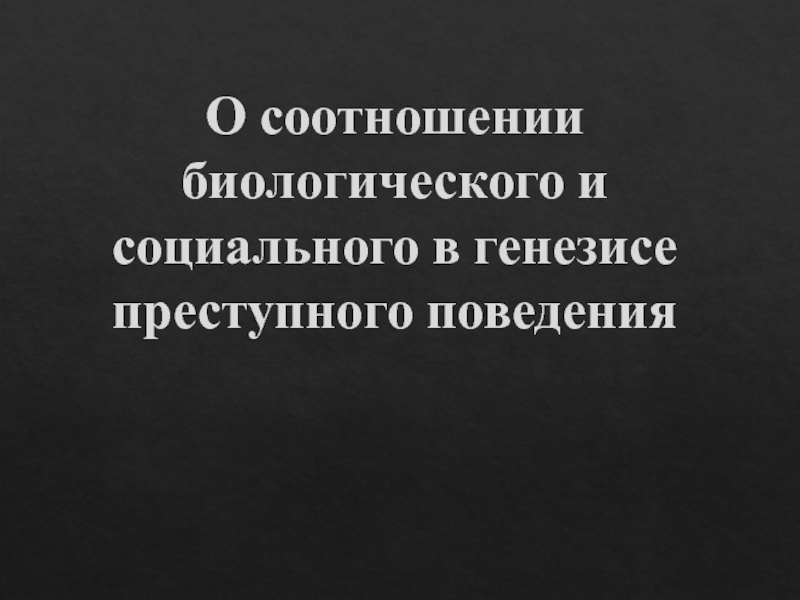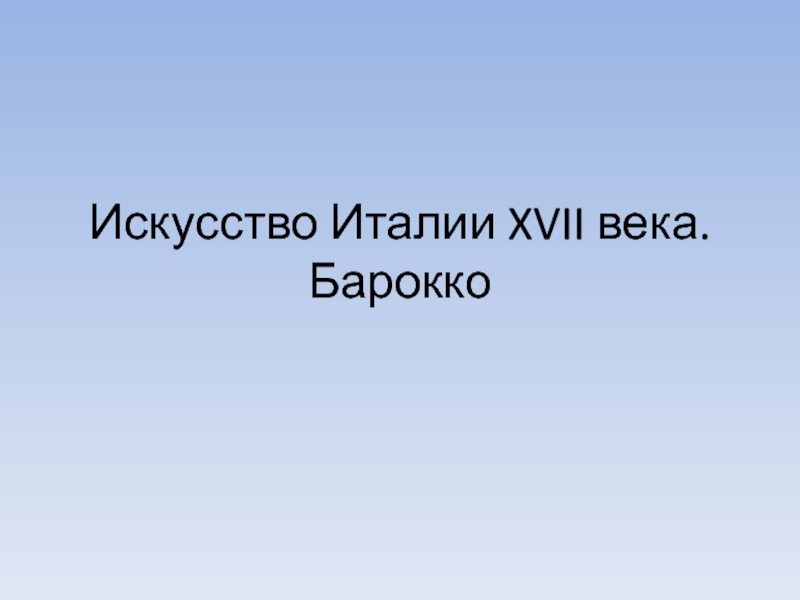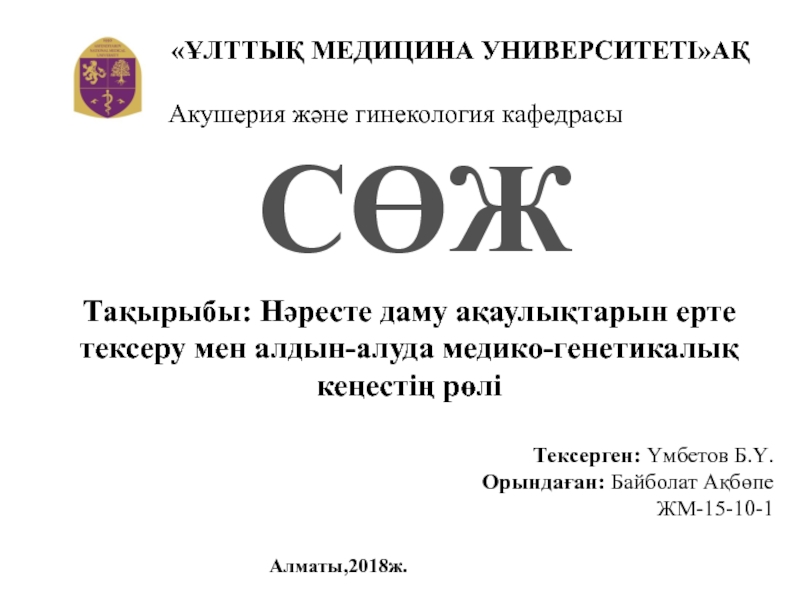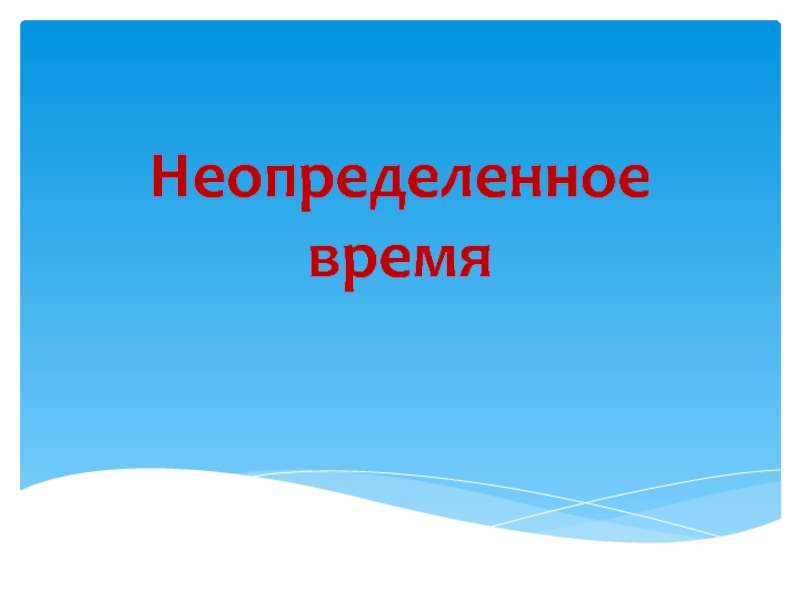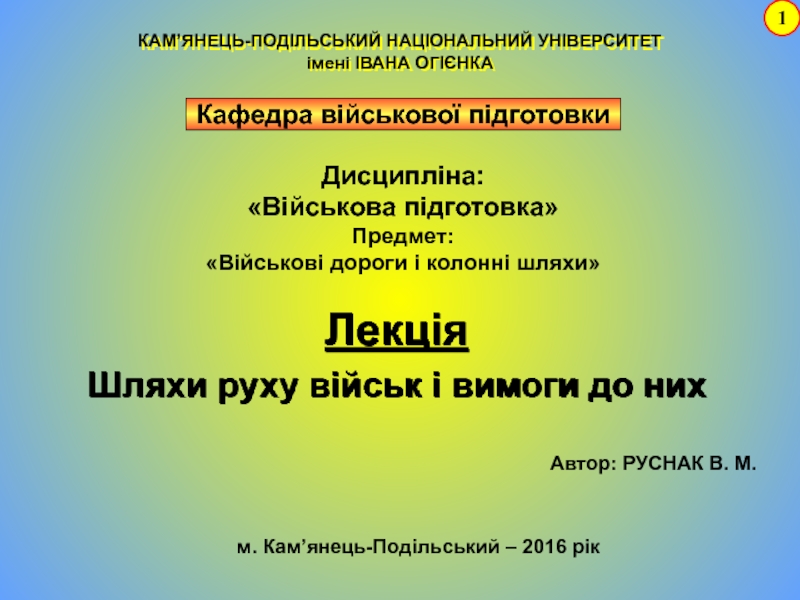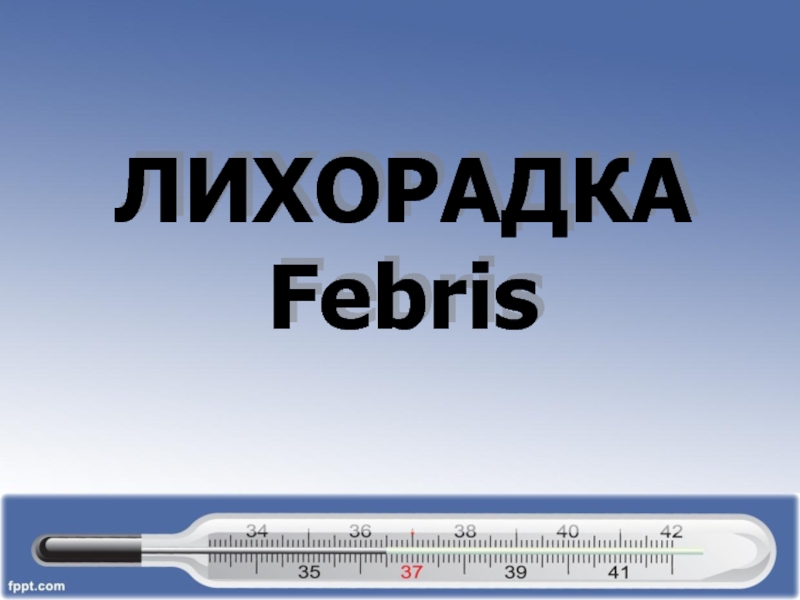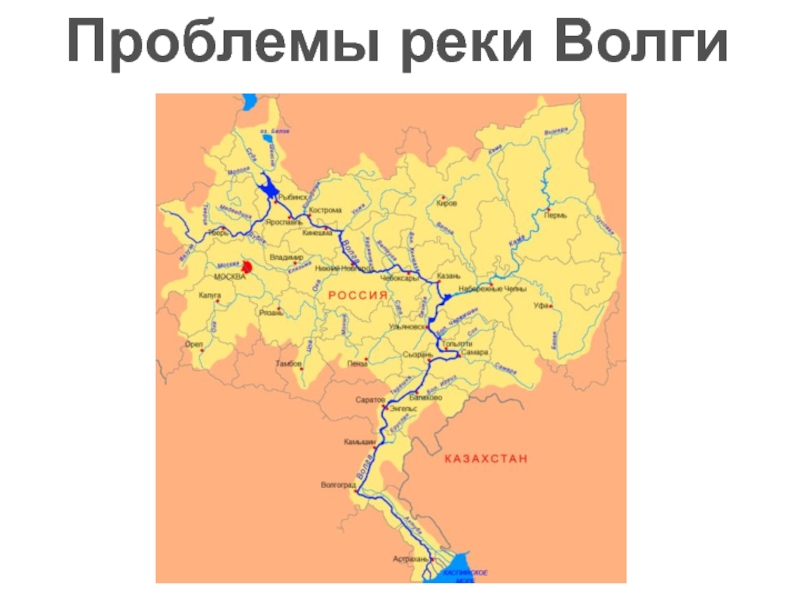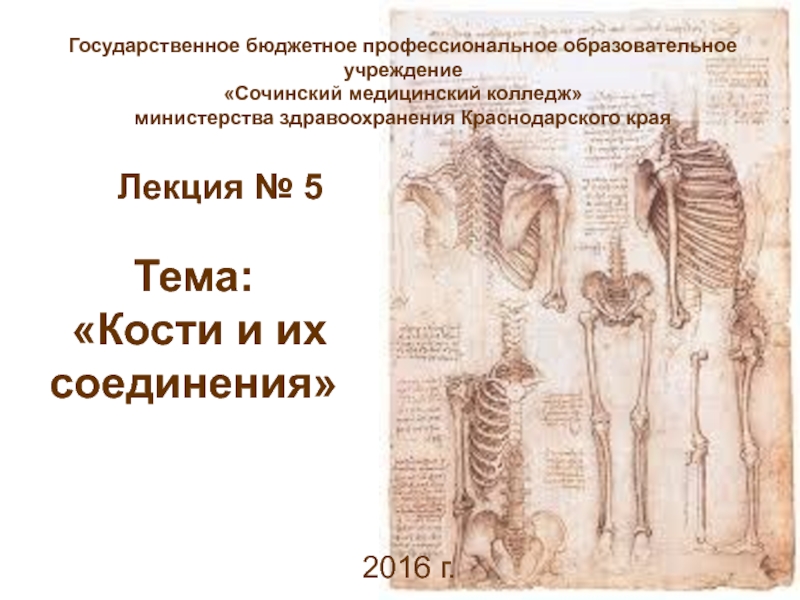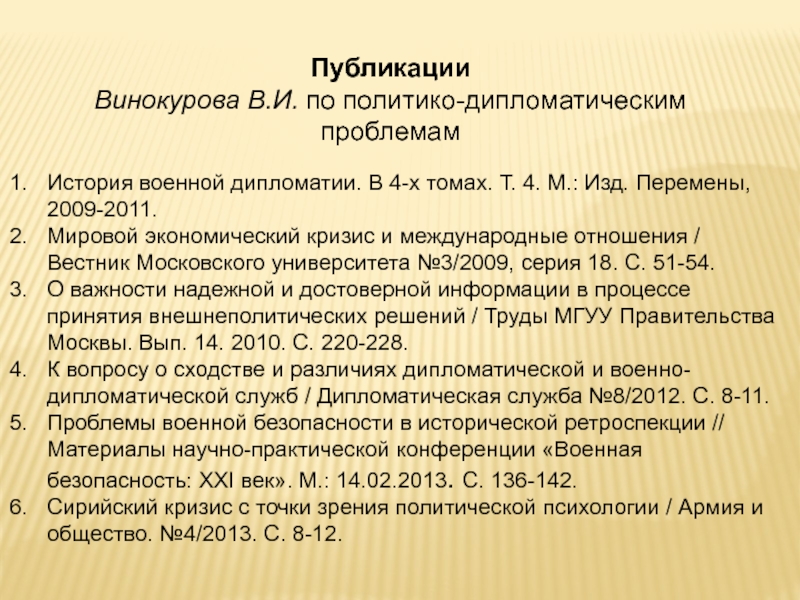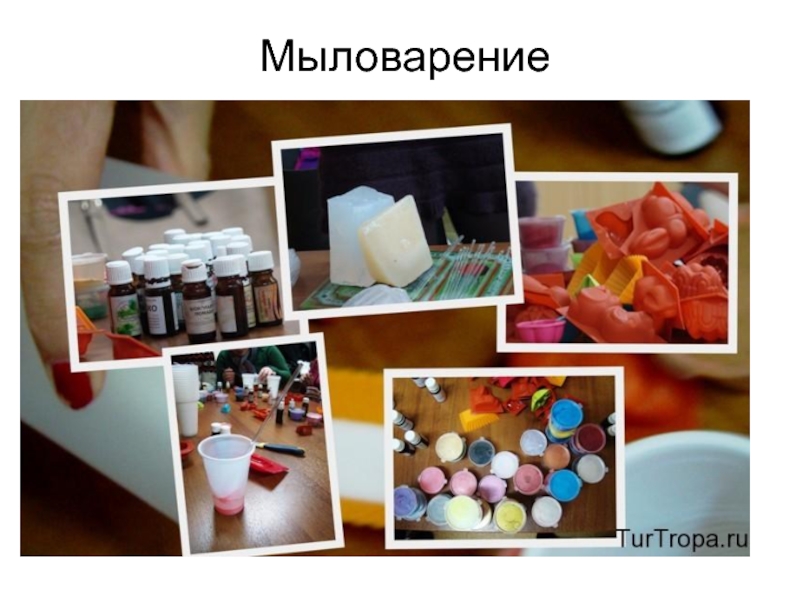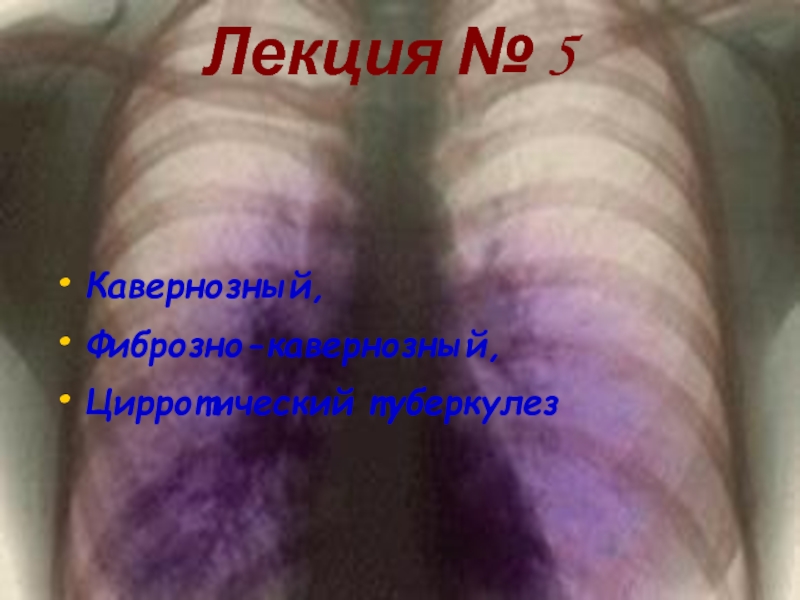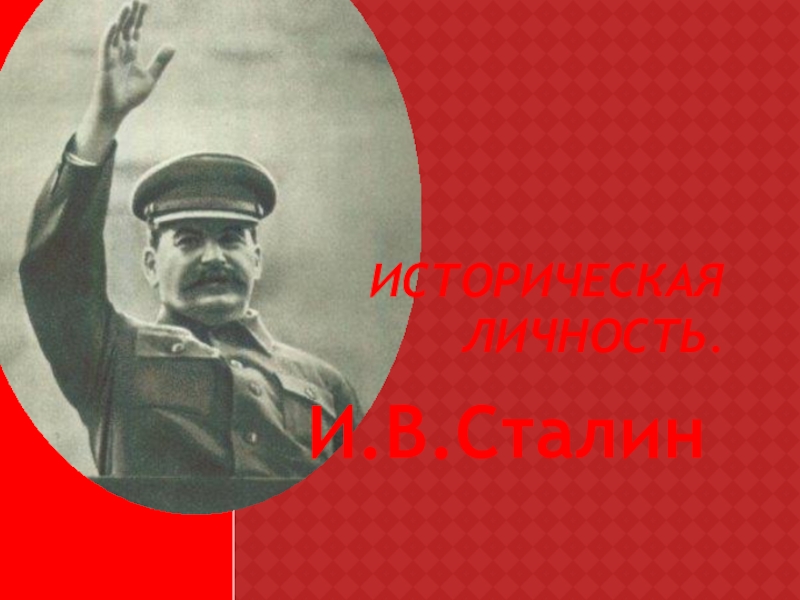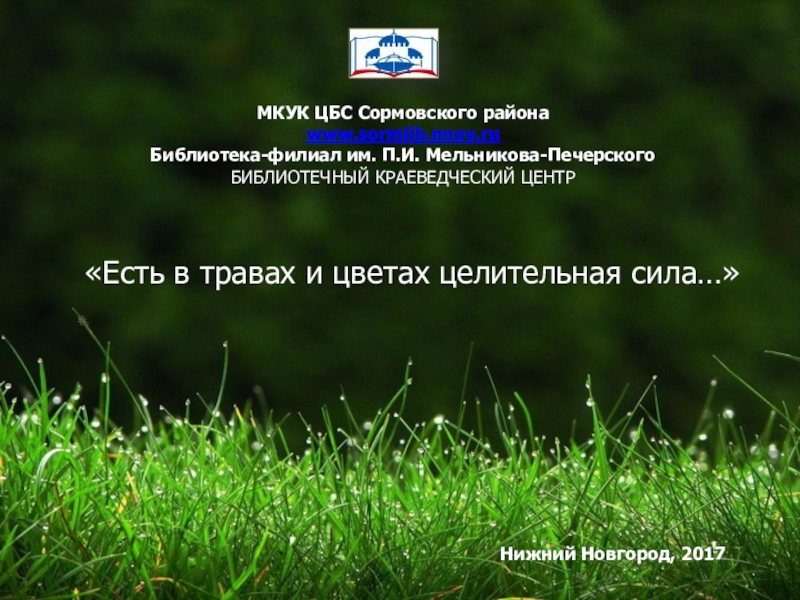Слайд 1Subject: General principles of the organization of behavior. Concept about
higher nervous activity. The congenital and acquired forms of behavior.
The
doctrine of Nominative of Pavlov about a conditioned reflex.
Characteristic of conditioned reflexes.
Technique of development of conditioned reflexes.
Difference of conditioned reflexes from the unconditional.
Types of conditioned reflexes, dynamic stereotype.
Temporary communication – a basis of a conditioned reflex,
education mechanisms.
Analitiko-sintetichesky activity of a cortex
brain.
Слайд 2 For the first time reflex nature of activity
of the highest departments of a brain was shown
I.M.Setchenov (1863)
in the book "Brain reflexes.
At the beginning of the XX century thanks to works of Nominative of Pavlov there was a radical revolution in studying of function of a cerebral cortex. The doctrine about higher nervous activity, as to a basis of behavior of the person is framed.
It showed that all reflex reactions can be parted on two groups: instinctive and conditioned reflexes.
Слайд 3Instinctive reflexes
It is a series independent, being transferred
by inheritance,
the congenital reflex
the mechanisms created in process
филогенеза, for maintenance
of the normal
organism vital activities in it
interaction with rather
constant conditions of the surrounding
mediums.
Слайд 4Conditioned reflex – adaptive reaction of an organism to changing
conditions of medium. They are individually specific, have alarm precautionary
character and are formed on the basis of instinctive reflexes.
Слайд 5The technique of development of conditioned reflexes is developed in
laboratory of Nominative of Pavlov.
The conditioned reflex at animals
can be developed on the basis of an instinctive reflex when keeping a series of the basic rules
Слайд 6I ruled developments of a conditioned reflex
Coincidence in time of
two stimuli: indifferent (light, sound) and unconditional (nutrition, pain).
The indifferent
stimulus has to precede the unconditional.
The conditional stimulus according to the physiological characteristic and biological importance has to be more weak than the unconditional
Слайд 7For formation of conditioned reflexes it is necessary active (vigorous)
condition of a cerebral cortex.
During formation of conditioned reflexes the
cerebral cortex has to be free from other, foreign stimuli.
The animal has to be absolutely healthy.
Fixing of conditioned reflexes requires a repeated combination of conditional and unconditional signals.
Слайд 8Technique of development of a conditioned reflex
Слайд 9Development of a conditioned reflex on Nominative to Pavlova
Fistula for
the saliva collecting
Call
(conditional stimulus)
Nutrition
(the unconditional
stimulus)
Слайд 10Tool conditioned reflex
Педаль
Кормушка
Слайд 11Difference of instinctive and conditioned reflexes.
Слайд 12Types of conditioned reflexes
І. By a development technique:
1 . Cash:
a) Coinciding (0,5-1 sec.);
b) Korotkoostavlennye (3 - 5 sec.);.
Слайд 13c) Normal (10-30 sec.)
d) Dlitelnoostavlennye (30 - 60сек);
e)
Late (1-5 min.)
.
Слайд 14Types of conditioned reflexes
2 . Trace.
Слайд 153 . Reflexes І - го and ІІ-go and higher
orders.
I order
II order
III order
Слайд 16Types of conditioned reflexes
4 . Summarized.
Call +пища = 8 drops
of a saliva
Light + nutrition = 12 drops of a
saliva
Ring and light + nutrition = 20 drops of a saliva
5 . Generalized
1000 Hz + nutrition – salivation
1000 Hz – salivation
1100 Hz - salivation
900 Hz salivation
Слайд 17Types of conditioned reflexes
6 . Differentiated.
1000 Hz +
nutrition – salivation
1000 Hz – salivation
1100
Hz - we don't support with nutrition (there is no salivation)
900 Hz - we don't support with nutrition (there is no salivation)
Слайд 18Types of conditioned reflexes
7 . Complex (simultaneous, consecutive, dynamic stereotype)
Simultaneous
(on some stimuli one reinforcement is given)
Consecutive (on some consecutive
stimuli one reinforcement is given)
Слайд 19Dynamic stereotype
The recorded system from the conditioned and instinctive reflexes
which have been iced over in a uniform functional complex.
It is formed under the influence of in the same way repeating changes and influences of external and internal medium.
call– 12 saliva thaw
light + food
light– 15 saliva thaw
mechanical+ food
mechanical– 8 saliva thaw
Mechanical – 12 saliva thaw
call– 15 saliva thaw
light– 8 saliva thaw
Слайд 21
8 . Imitative.
They are formed without active participation
in process of their development. Arise at observation over development
of conditioned reflexes at other animal or the person. To Naprima at children reche-motive reactions and formation of social skills.
Слайд 22ІІ. In the location of receptors:
1 .
Exteroceptive;
2 . Proprioceptive;
3 .
Interoceptive.
ІІІ. By the nature of a conditional stimulus:
1 . Natural;
2 . Artificial.
IV. On biological value:
1 . Alimentary;
2 . Defensive;
3 . the sexual;
4 . Approximate.
Слайд 23V. On nature of response:
1 . Vasomotor;
2 . Sektrotornye.
3 . Motor;
4 .
Excretory, etc.
VI. Special type of a reflex – a reflex for a while.
VII. On influence on process course:
1 . Excitative;
2 . Brake.
Слайд 24 Instincts - the difficult congenital standard adaptive mental phenomena
based on motivations and realized in the form of unconditional
and reflex behavioural reactions
Слайд 25Instincts are a difficult complex of instinctive reflexes with conditioned-reflex
stratifications.
Realization of instincts the leading role is played by
subthalamic area and limbic system.
Слайд 26At the heart of formation of a conditioned reflex temporary
communication lies.
This functional association of two or several centers
of a cortex and the subcortical structures providing exercise of reactions to conditional and unconditional stimuli.
This communication depending on conditions of finding of an organism can be fixed or disappear.
Слайд 27Theories of short circuit of temporary communication
The theory of two
cortical centers of Nominative of Pavlov – irradiation, a majorant
and protoreny ways
Theory of corticosubcortical communications (E.A.Aasratyan)
The convergence theory on P.K.Anokhin's 1 neurone - 1 stage: generalization, 2nd stage: concentration or convergence
Слайд 28Formation of temporary communication on the way "cortex cortex" on
Nominative to Pavlova
Слайд 29Formation of temporary communication on the way "cortex-subcortex-cortex" according to
E.A.Asratyan
Слайд 30Formation of temporary communication by convergence on a neurone according
to P.K.Anokhin
Слайд 31Mechanisms of formation of temporary communication in a cerebral cortex
1
. Exaltation irradiation.
2 . Dominant exaltation of the center.
3 .
Protoreniye of a way.
4 . Convergence.
5 . Morphological changes in synapses (decrease of a synoptic cleft, growth of the shipikovy device).
6 . Biochemical changes (information coding in RNA and DNA molecules, synthesis change proteins).
7 . Neyrogiya participation (synthesis of the special substances facilitating synoptic transfer, promotes a miyelinikhzation of naked nervous bombways).
Слайд 32Studying conditioned reflexes, Nominative Pavlov came to a conclusion that
all activity of a brain is under construction of two
processes:
- exaltations;
- inhibitions.
Rasprostreniye exaltations can provide the generalized reactions covering a series of organs and systems.
Concentration of process can provide narrowing of reflex reaction, its focus.
Inhibition can be generalized and concentrated.
There are some types of cortical inhibition during which exercise conditioned reflexes are oppressed.
Слайд 33Types of inhibition
External (unconditional) inhibition arises:
1 . At action
of a new stimulus
2 . When giving a strong stimulus
(ultraboundary).
Слайд 34
The first type of external inhibition arises right after giving
a postorenny stimulus, i.e. doesn't demand development.
In some cases
it can be characterized as approximate reaction.
There is a reflex: "what the such? " Previous reflex activity thus stops.
Слайд 36The second type of unconditional inhibition received the name -
"ULTRABOUNDARY INHIBITION".
It arises at excessive augmentation of force and
duration of action of a conditional stimulus.
I.e. force of a stimulus exceeds operability of cortical cells.
This inhibition has protective value.
Слайд 38Internal inhibition
Internal (conditional) inhibition demands special development. The biological sense
of internal inhibition consists that new environmental conditions demand change
of conditioned-reflex activity.
Слайд 39There are four types of internal (conditional) cortical inhibition:
ugasatelny
differentsirovochny
the late
conditional brake.
Слайд 40Ugasatelnoye - inhibition develops if not to support the developed
reflex with an unconditional stimulus.
Thus the conditional stimulus loses
value of a signal and reaction to it is slowed down, but the conditioned reflex doesn't disappear and can be restored if again to support it with an unconditional stimulus.
Слайд 41Differentsirovochnoye inhibition arises at development of a differentsirovochny conditioned reflex.
For example, if not to support one sound, on it
reaction, and other sound disappears to support that on it there is a conditioned reflex.
Слайд 43
Late inhibition arises when the reinforcement of a prearranged signal
is carried out by an unconditional stimulus with delay (2-3
min.).
Слайд 44Late inhibition
call
food
food
food
call
call
Слайд 45Late inhibition
call
food
food
food
call
call
Слайд 46The conditional brake arises in those cases when to a
conditional stimulus on which the reflex is developed, to add
a new stimulus and a complex not to support. Then the reflex to be braked as new stimulus to become a conditional brake.
Слайд 47Dynamics of the main cortical processes (exaltation and inhibition).
Irradiation -
exaltation diffusion from the central center on a surrounding zone.
Concentration
- opposite process reduction of a zone of the center of exaltation.
Слайд 48Induction – targeting of opposite process (exaltation and inhibition).
Happens the
following types:
The simultaneous
The consecutive
The positive
The negative.
Слайд 49In the course of formation of new conditioned reflexes, in
the course of their fading there is a gradual change
of process of exaltation with inhibition.
By Pavlov's works and his employees it is shown that change though quickly happens, but not instantly, and gradually.
Слайд 50Transitional phases from exaltation to inhibition.
I.Уравнительная. When the conditional stimulus
of various force causes one effect
II. Paradoxical. The size of
conditioned reflexes decreases by a strong boring and is enlarged by the weak.
III. Ultraparadoxical. It is characterized by that a positive conditional stimulus gives brake effect, and negative on the contrary causes positive reaction. All these observations allowed Pavlov I.P. to develop a technique of experimental neurosises.
IV.Тормозная. When there is no reaction to any boring.
Слайд 51Subject: " The VND types, the doctrine of Nominative of
Pavlov about I and II alarm systems".
The doctrine of Nominative
of Pavlov about a conditioned reflex.
Characteristic of conditioned reflexes.
Technique of development of conditioned reflexes.
Difference of conditioned reflexes from the unconditional.
Types of conditioned reflexes, dynamic stereotype.
Temporary communication – a basis of a conditioned reflex,
education mechanisms.
Analitiko-sintetichesky activity of a cortex
brain.
Слайд 52Modern ideas of the VND types are substantially identified with
four types of human temperament allocated still with Ancient Greek
doctor Hippocrates (ІV in B.C.) on the basis of observation over behavior of people.
The choleric;
The melancholic;
The Flegmatic;
The sanguine.
Слайд 53Nominative Pavlov, studying development and fixing of conditioned reflexes at
dogs, I defined that an important role in formation like
nervous activity is played by properties of cortical processes: FORCE, STEADINESS, MOBILITY.
Force is degree of expression of processes of exaltation and inhibition.
Steadiness – a ratio of processes of exaltation and inhibition in total amount of biological reactions.
Mobility – rate of emergence and speed of change of processes of exaltation and inhibition.
Taking into account these properties of Nominative Pavlov allocated four VND types.
Слайд 55Live type - strong, counterbalanced and mobile.
It is characterized by
big energy, force, mobility.
Corresponds to sanguine type according to Hippocrates.
Слайд 56The quiet – strong, counterbalanced, inactive.
It is characterized by
the sufficient force of processes of exaltation and inhibition, their
rather low mobility.
Corresponds to flegmatic type according to Hippocrates.
Слайд 57The impetuous – strong, unbalanced, mobile,
with prevalence of processes
of exaltation.
Corresponds to choleric type according to Hippocrates.
Слайд 58Weak (inert) – unbalanced, inactive with prevalence of brake process
over excitative.
Corresponds to melancholic type according to Hippocrates.
Слайд 59The HNA types are formed on a basis as genotype,
and phenotype, i.e. on genetically put features of nervous system
all variety of influences of education, conditions of environment, situations in which there is an organism is imposed.
Слайд 60Nominative Pavlov framed the doctrine about the first and second
alarm systems.
The first alarm system is visual, acoustical and other
sensual signals which proceed from world around and internal medium of an organism. It is the general for the person and animals.
Слайд 61The second alarm system – verbal, inherent only to the
person. As its signals words said, heard, read serve. By
means of the word transition from a sensual image of the first alarm system to representations of the second alarm system is carried out.
Слайд 62
Pavlov allocated with nominative the HNA specific types inherent in
the person in connection with existence of speech (ІІ-y alarm
system), its ideational and creative activity.
Слайд 63The first type – art.
People with a pronounced visual
and acoustical susceptibility of environment, i.e. prevalence І - oh
alarm system, the concrete, figurative thinking (in the most part it is artists and musicians) is expressed.
Слайд 64The second type – ideational. Differs predilection to logical and
abstakty thinking, prevalence ІІ-oh alarm system (scientists, philosophers, mathematics).
Слайд 65
The third type - admixed. Properties of perception of environment
and thinking are expressed to the same extent.
Слайд 66HNA specific types.
А- average type :
I сс =II сс
B –artistic: I сс >II сс
V- cogitative : I сс
Слайд 67Speech functions:
The word – "a signal of signals"
Means of
social communication
Educational tool and self-expression
Sposobstuyet to thinking
The
information
Participation in memory mechanisms
The physiology of speech function includes rechevospriyaty and a rechereproduktion.
Слайд 68
In the left temporal share there is a center of
heard speech and the center touch speeches (the center to
Vernika).
At destruction of this zone of people hears, but doesn't understand value of that hears.
Слайд 69
In a frontal lobe of the left hemisphere is the
motor center (Brock).
At its destruction of people loses ability to
speak, but understands when to it address orally or in writing.
In an occipital share there is a center of visible speech (reading the letter)
Слайд 70Primary speech zones of bark
Zone
Brock
Zone
To Vernika
Слайд 71The structures of a brain participating in speech function
Слайд 73Speech violations:
Motor aphasia (Brock's frontal aphasia) – can't say the
word, but understands speech
Touch aphasia (temporal aphasia to Vernika) –
frustration of perception of speech, i.e. doesn't understand the word
Alex – loss of ability to read silently and aloud
Amuziya – frustration of musical perception
Amnestichesky (parietal) aphasia – a zabyvaniye of separate words, is more often than nouns.
Akalkuliya – account frustration
Agraphia (the bottom frontal crinkle of the left hemisphere and sites of parietal bark is struck) – loss of ability to write
Слайд 74
Functional asymmetry of a brain
The left and right hemispheres are
responsible for different functions, i.e. there is a mezhpolusharny asymmetry.
Слайд 75The left hemisphere (partially dominating):
Verbal perception (verbal);
Temporary relations;
Analysis of incentives;
Consecutive perception;
Easily distinguishable subjects;
Familiar subjects;
Similarity establishment;
The abstract
thinking, the generalized recognition;
Слайд 76Right hemisphere :
Nonverbal perception (visual);
Spatial relations;
Synthetic activity.
Simultaneous perception;
Concrete thinking;
Difficult distinguishable
subjects;
Unfamiliar subjects;
Distinction establishment;
Complete perception.
Слайд 77Memory –
this all-biological property
accumulation, storages, processings and information
vosprozvedeniye.
Memory consists of 4 processes :
Storing;
Storage;
Recognition;
Reproduction.
Слайд 78As a result of process of learning there are physical,
chemical and morphological changes in nervous structures which remain some
time and have essential impact on reflex reactions carried out by an organism.
Слайд 79
Set of structurally functional changes in nervous educations as a
result of learning process, is called ENGRAMMA (trace) of operating
irritants.
Слайд 80Types of memory :
1 . Specific is the information which
has been saved up as a result of evolution throughout
the millennia. These are unconditional reflex instincts.
2 . Individual - information acquired in individual life and being realized in conditioned reflexes.
Слайд 81In a manifestation form
The figurative
Emotional (storing of the endured feelings,
inspiration, pleasure, fear)
Logical or verbal
The touch
visual (at artists)
acoustical (at musicians)
tactile
(at blind)
5 . Mechanical or motor (at athletes, ballerinas)
Слайд 82the motor
the figurative
verbally - logical
the emotional
Слайд 83Types of memory :
According to the temporary characteristic or duration
Instant
(ikonichesky) - is stored no more 100-150ms
Consists in formation of
an instant print, a trace of operating incentive in receptor structure.
Biological value – recognition of images and touch signals analizatorny structures of a brain.
Слайд 842 . Short-term (quick) - provides performance of the current
behavioural and cogitative operations.
In a basis reverberation processes lie.
Remains from
several seconds to several minutes
Слайд 853 . Long-term - it is stored for life
Process of
transformation of short-term memory in the long-term – memory consolidation.
The mechanism - approach of permanent changes of synoptic conductivity as result of repeated excitement of nervous cages and allocation by glial cages of the substances improving synoptic transfer.
Слайд 87Memory depends :
from age
health
interest
trenirovannost
motivations
Слайд 88Physiological mechanisms of memory
How the person the imprinted events are
reproduced it is possible to define level and force of
manifestation of memory. Distinguish three levels of memory :
1 . the highest level – reproducing memory, literal reproduction.
2 . level – identifying memory, identifies earlier seen, a subject, the text, a picture.
3 . level – facilitating memory. Independently doesn't remember, but at new studying less time is required.
Слайд 89Memory theories
The conditioned-reflex - at the heart of memory lies
education and the subsequent preservation of temporary communications.
The theory neural
models - the Physical point of view. Neural models represent as group of nervous cages, communications their steady in time information on memory bear electronic signals. When these signals repeatedly approach to the same synapses, change their electric and mechanical characteristic that facilitates formation of conditioned reflexes. Nervous electronic impulses being grouped in time and space form dynamic neural models.
Слайд 903 . Associative - psychological (will be coordinated with the
theory of neural models). Remembered events, concepts are connected so
that "revival" of one conducts to "revival" of others. This theory says that memoirs are reproduced in the same sequence in which they arose for the first time. It is connected with the theory of neural models (those neurons which are more closely to each other located are quicker raised, activated, is closer on arising representations). Associations are very important at reminiscence.
Слайд 914 . Chemical – it is considered that storing process
is influenced positively by RNA, strengthening a proteinaceous exchange and
increasing excitement processes in neurons, than formation of temporary communication in a cerebral cortex is facilitated. Specific proteins N-peptides are received.
Слайд 92Disorders of memory
Storing violation - fixings
Storages – retention
Reproduction – a
reproduction
Amnesia – impossibility of reproduction of the past, skills.
Gipermneziya –
reminiscence flows (an initial stage of intoxication)
Gipomneziya – easing of memory of a retention, a reproduction first of all names, dates.
Anterogradny amnesia – inability to assimilation of new information (Karsakov's syndrome), is lost ability to information transfer from primary and in secondary memory
Retrograde amnesia – loss of ability to extraction of information saved up (concussion, a stroke, an electroshock) under hypnosis comes back to memories.
Hysterical amnesia – total loss of memory – purely functional – it is frequent after stresses.
Слайд 93Subject: " Dream, dreams. Emotions. Motivations"
Plan :
1 . Dream, types
of a dream.
2 . Dream mechanisms.
3 . Emotions. Classification of
emotions.
4 . Theories of emotions.
5 . Motivations.
6 . Architecture of the complete behavioural act.
Слайд 94Dream – a condition of an organism which is characterized
by considerable decrease in all functions of an organism, partial
shutdown of consciousness.
Types of a dream:
1 . Physiological dream:
- polyphase dream at children;
- monophase dream at adults;
- seasonal dream;
2 . Hypnotic dream.
3 . Electrodream, electroanaesthesia
4 . Pathological dream:
- narcotic dream;
- somnambolizm (sleepwalking);
- lethargical sleep.
Слайд 95The physiological dream consists of two alternating phases:
- slow or
orthodox dream of 75-85%
REM or paradoxical sleep (15-25%).
Слайд 96Dream stages :
1 . Somnolence - disappearance a rhythm alpha,
1-7 min. There is MDG
2 . Emergence of sleepy spindles
on EEG – to 50% of a dream. DG isn't present
3 . Emergence delta flounce, 20%. DG isn't present
4 . Paradoxical dream – a beta a rhythm (a rhythm of active wakefulness), flashes an alpha of a rhythm, BDG.
Слайд 97Dream theories:
1 . Humoral (chemical);
2 . Nervous theory
- The
theory of the poured braking of Nominative of Pavlov.
- V.
Gess's theory
3 . Theory of information deficiency.
4 . Vazomotorny
6 . Histologic
Слайд 98Humoral theory of a dream
1 . Accumulation of products
of a metabolism in
time of the period of wakefulness.
2 .
Availability of chemicals
гипнотоксинов, causing a dream -
серотонин, GAMK
Слайд 99Nervous theory
1 . Nominative theory the Pavlova-poured cortical braking, i.e.
the internal braking irradiating on bark and extending on underlying
departments of CNS
2 . V. Gess's theory - excitement of a ventro-medial kernel гипоталамуса
Слайд 1003 . Theory of information deficiency
restriction of touch inflow of
information.
4 . The Vazomotorny theory connects
dream emergence with changes
brain
blood supplies
5 . The histologic theory believes that
emergence of a dream depends from
reduction of a synoptic crack and
shortenings of dendrites
Слайд 101Biological value of a phase of a slow dream (orthodox
phase): - sensitivity fall to external irritants
Vegetative shifts
decrease in
frequency of warm reductions and arterial pressure,
breath delay
Слайд 102Biological value of a phase of a REM sleep (paradoxical
phase):
- processing and information adjournment in long-term memory,
-
restoration of mental processes
Vegetative shifts - "a vegetative storm“
Arrhythmic pulse,
Arrhythmic breath,
Increase AP,
Increase in frequency of warm reductions ,
FME – fast movements of eyeballs
Слайд 103Dreams – always accompany a dream and are more often
connected with a phase of a paradoxical dream.
Dreams are explained
by that in bark remain less braked (awake, sentry) the centers being in a condition of a dominant.
I.M.Setchenov characterized them as "unknown combinations of skilled impressions".
Слайд 104Emotion (I induce, I excite) – a physiological condition having
pronounced subjective coloring.
Emotions is a component of motivations.
Слайд 105Distinguish concepts:
1. Emotional stress
- Эустресс – a positive stress (high
spirits... )
- Distress - a negative stress (leads to
a disease)
2 . Affect – rough emotion when the person loses control over himself.
3 . Mood – long, weaker emotion (" +" and "-").
Слайд 109Theories of emotions:
1 . C.Darvina's theory (instinctive action) - Emotions,
as рудимет expedient instinctive actions
2 . P.K.Anokhin's biological theory
- Emotions, as the product of long evolution directed on the adaptation of an organism to life situations. Emergence of requirements is accompanied "-" emotion, and their satisfaction – "+" by emotion.
Слайд 1103 . P. V. Simonov's information theory - Emotions, as
reflection by a brain of size of requirement and satisfaction
Э
= П (requirement) x (ИН – ИС);
ИН – necessary information,
Ис – existing information.
Если П=0, то Э «нет»
Если Ис < Ин,то Э «-»
Если Ис >Ин, то Э «+»
Слайд 1114 . G.I.Kositskogo's theory - Emotions, as reflection by a
brain of factors of time, energy resources and organism opportunities
Э
or СН = Ц х (Ин Эн Вн – Ис Эс Вс)
Э –emotion, СН - condition of tension,
Ц- purpose
Ин, Эн, Вн, – necessary information, energy, time
Ис Эс Вс – existing information, energy, time.
Слайд 112Stages of emotions or tension degree according to G.I.Kositskomu
CH-I (condition
of tension) - reflects a condition of attention, mobilization of
activity, working capacity increase. It is very useful to an organism.
CH-II (sthenic negative emotion) - is characterized maximum increase in energy resources of an organism and limit tension of bodies and systems (anger, indignation)
Слайд 113CH-III (asthenic negative emotion) - is characterized by exhaustion of
energy resources of an organism (horror, melancholy, decrease in intelligence,
a panic …)
CH-IV (neurosis) - represents a disease, VND failure, "breakage" of a number of regulatory mechanisms of an organism
Слайд 114Motivations are the emotionally painted aspirations of the person and
animals to satisfaction of leading requirements.
Motivations leads to purposeful search
behavior.
Interests – emotional manifestation of informative need of the person.
Types of motivations:
1 . The lowest (biological, vitalny).
2 . The highest:
- the social.
- the ideal.
Слайд 115 INTEGRATIVE ACTIVITY
BRAIN
AND FORMATION
BEHAVIOURAL ACT
Слайд 116 Integrative activity of nervous system – generalizing activity, underlies
the behavioural act.
The main and specific manifestation of
activity of CNS is the reflex.
Слайд 117 According to the classical theory, the reflex comes to
an end with action. Nominative Pavlov, then P.K.Anokhin showed that
the reflex act doesn't come to the end with reciprocal action, and there is an analysis of results of action by nervous system and comparison of the valid result to the desirable.
Слайд 118 Information on result of action arrives in CNS on feedback
therefore the concept about a reflex ring is entered.
The
behavior of an organism is defined by result of perfect action.
Слайд 119According to modern representations the reflex is a difficult dynamic
system with feedback.
Basis of physiological structure of any
behavioural act is the functional system.
Слайд 120 Functional systems are morfofunktsionalny devices of self-control in an organism.
The doctrine about functional system was developed by P.K.Anokhin (1935).
Слайд 121Basis of the behavioural act is the functional system (FS)
of P.K.Anokhin
Слайд 122 Formation of the behavioural act proceeds in some stages
:
afferentny synthesis;
making decision on the functioning purpose;
formation of the program
of action and action acceptor;
Result of action and return afferentation.
Слайд 123 The initial, nodal mechanism of the behavioural act is afferentny
synthesis – AC
AC– processing, comparison, synthesis of received information
is the most responsible moment of integrative activity of a brain which defines highlights of the behavioural act – what to do how to do when to work.
Слайд 124Into structure AC enter:
Dominating motivation - the dominating requirement connected
with a condition of an organism at present, evolved internal
requirement. (What to do? )
The starting afferentation – is caused by direct action of an irritant. (When to do? )
Obstanovochny afferentation – caused by action of a certain situation. (It is possible to do? )
Memory. (How to do? )
Approximate and research reaction (SHOUTING. ) .
Слайд 125 Thus the behavioural act is caused not only incentive, irritation
as it was approved by the classical reflex theory, and
and other components, from them the most important role is played by dominating motivation. In the absence of motivation there is no behavioural act, the organism doesn't react to incentive.
The behavior has to be motivated.
Слайд 126 In the solution of a question how to make action
a significant role play memory mechanisms.
First of
all, it is genetic memory to which congenital biological motivations are constantly addressed. Isn't less significant and individually acquired memory.
Thus at a stage the EXPERT the issues "what to do" (on the basis of external and internal irritations), "when to do" (on the basis of special starting factors) are resolved.
Слайд 127Neurophysiological mechanisms of afferentny synthesis
Ascending activating influences of subcrustal educations
on a cerebral cortex.
Descending influences of bark on subcrustal educations.
Reverberation
of vozbuzhdeniye between bark and subcrustal educations.
Mechanisms of convergence of vozbuzhdeniye of various touch and biological quality on cerebral cortex neurons.
Слайд 128Role of various departments of a brain
Processes of afferentny synthesis
happen in various departments of CNS. However the leading role
in EXPERTS mechanisms belongs to KGM, and first of all – to her frontal lobes.
The stage AC is a stage of dynamic search of information, some kind of "a stage of doubts". The EXPERT comes to an end with a decision-making stage.
Слайд 129Decision-making
At a stage of acceptance of the decision the dominating
line of conduct is developed.
After a stage of acceptance of
the decision the stage of efferent synthesis begins.
Слайд 130Efferent synthesis
Efferent synthesis – effector part of the behavioural act
consists from:
Action programs
Action Acceptor (AA)
Thus on a phase
of decision-making the model on which the result of action will be checked is under construction.
Слайд 131 For execution of action of CNS sends to executive body
of team to action.
At the same time on коллатералям
axons "copies" of teams to special neurons of the action acceptor (AA) are transferred
The HELL is the device perceiving, comparing, approving results of the action, comparing results of action with "copy".
Слайд 132Action
Behavioural action is always directed on achievement of potrebny
result, on active interaction of living beings with environment factors.
Слайд 133 Signals of results of action on feedback arrive in the
arterial pressure and are compared to "copy". If they coincide,
action comes to an end if isn't present, it leads to creation of new teams of action, afferentny synthesis (AC) mobilization
Слайд 134Basis of the behavioural act is the functional system (FS)
of P.K.Anokhin
